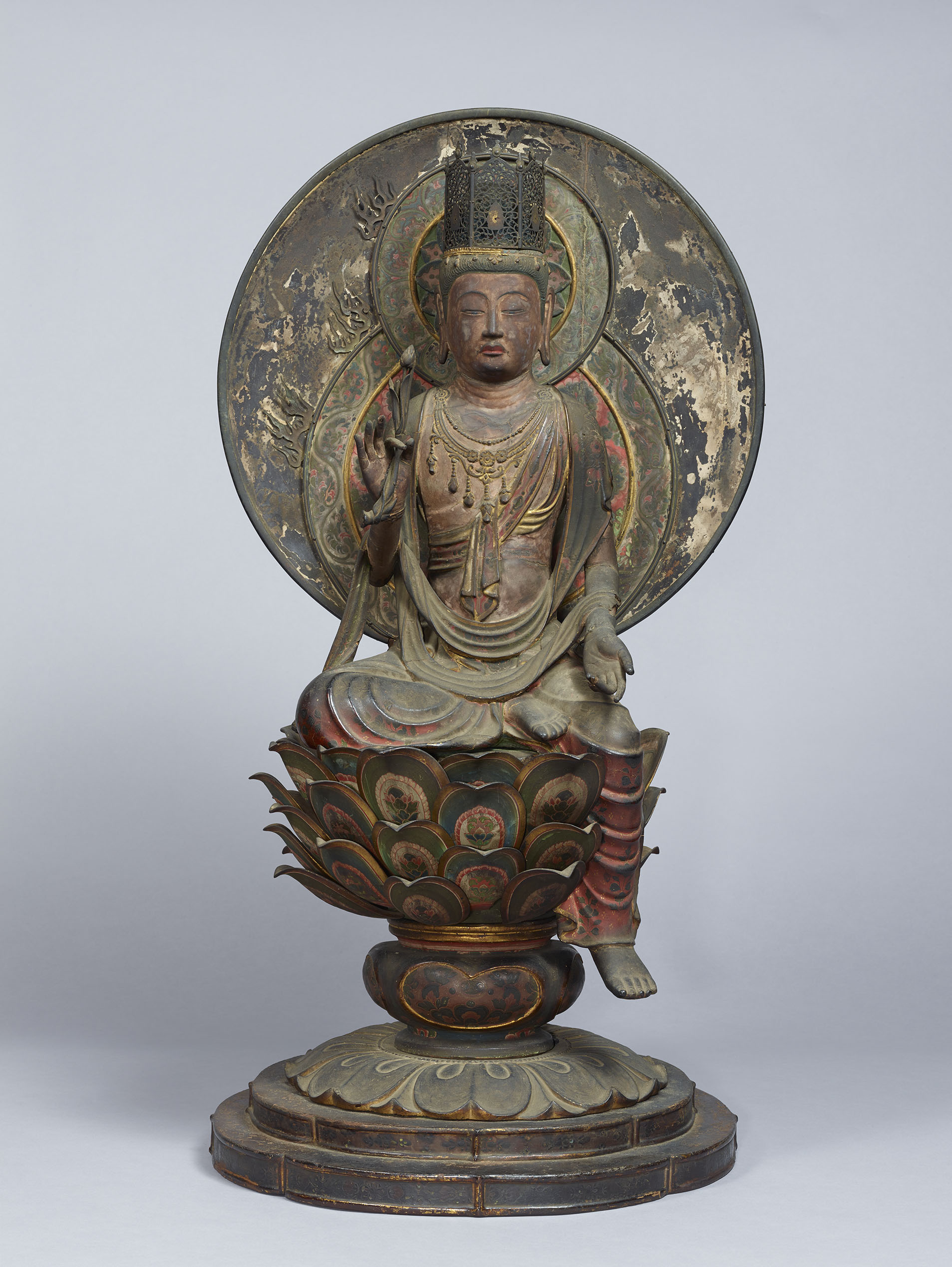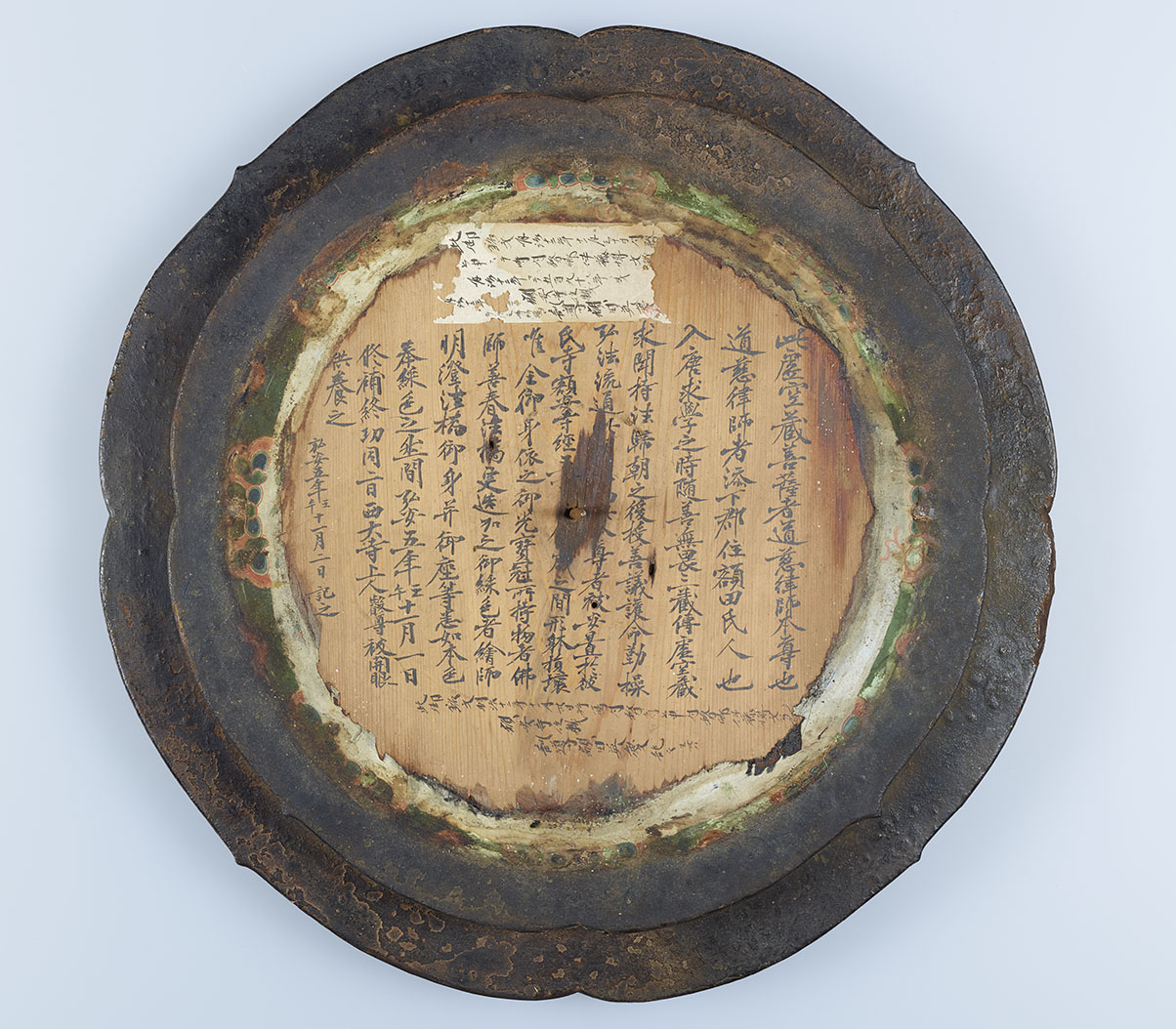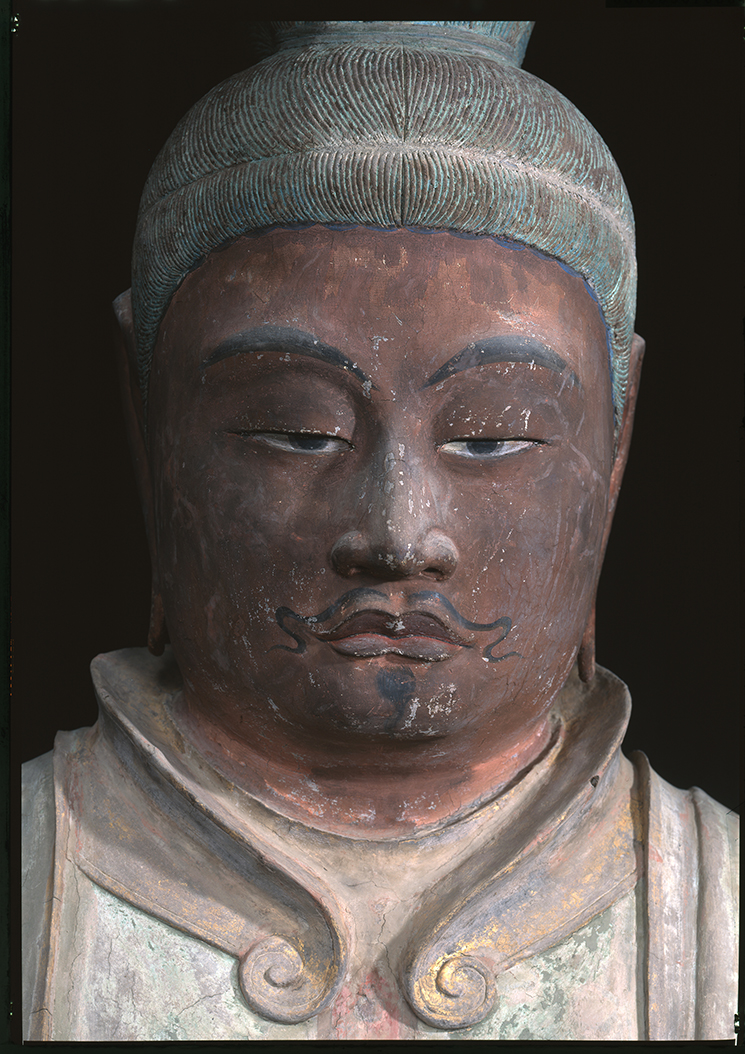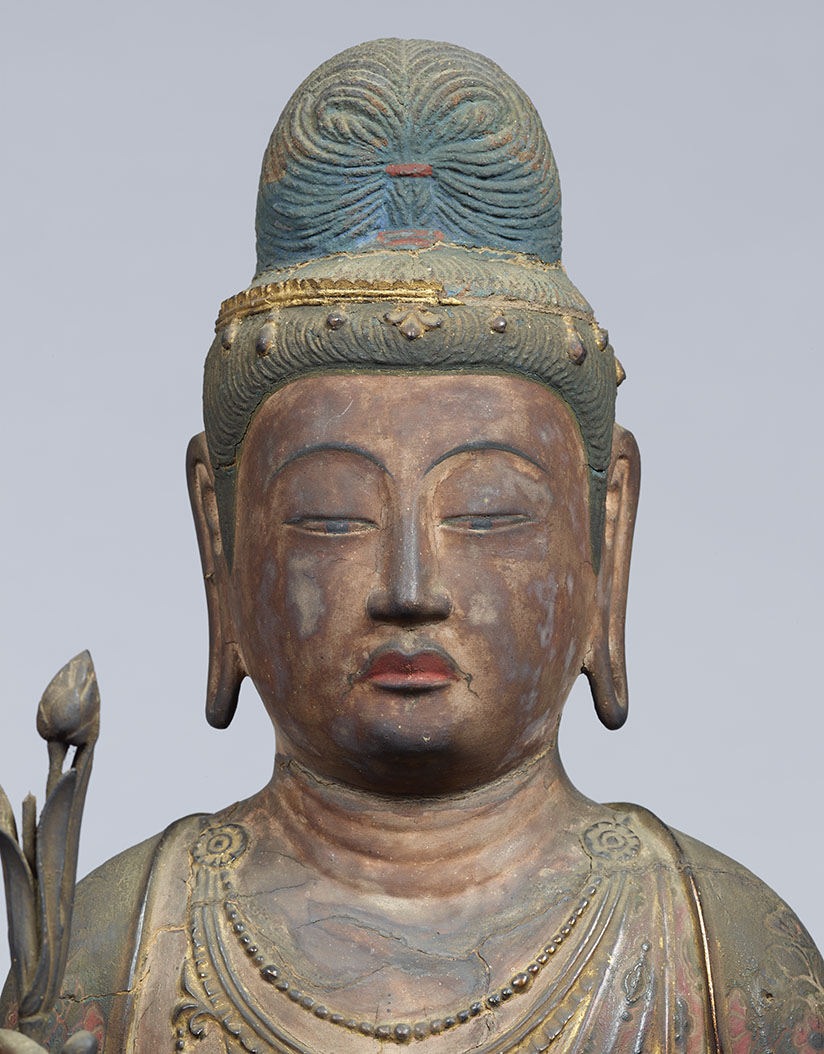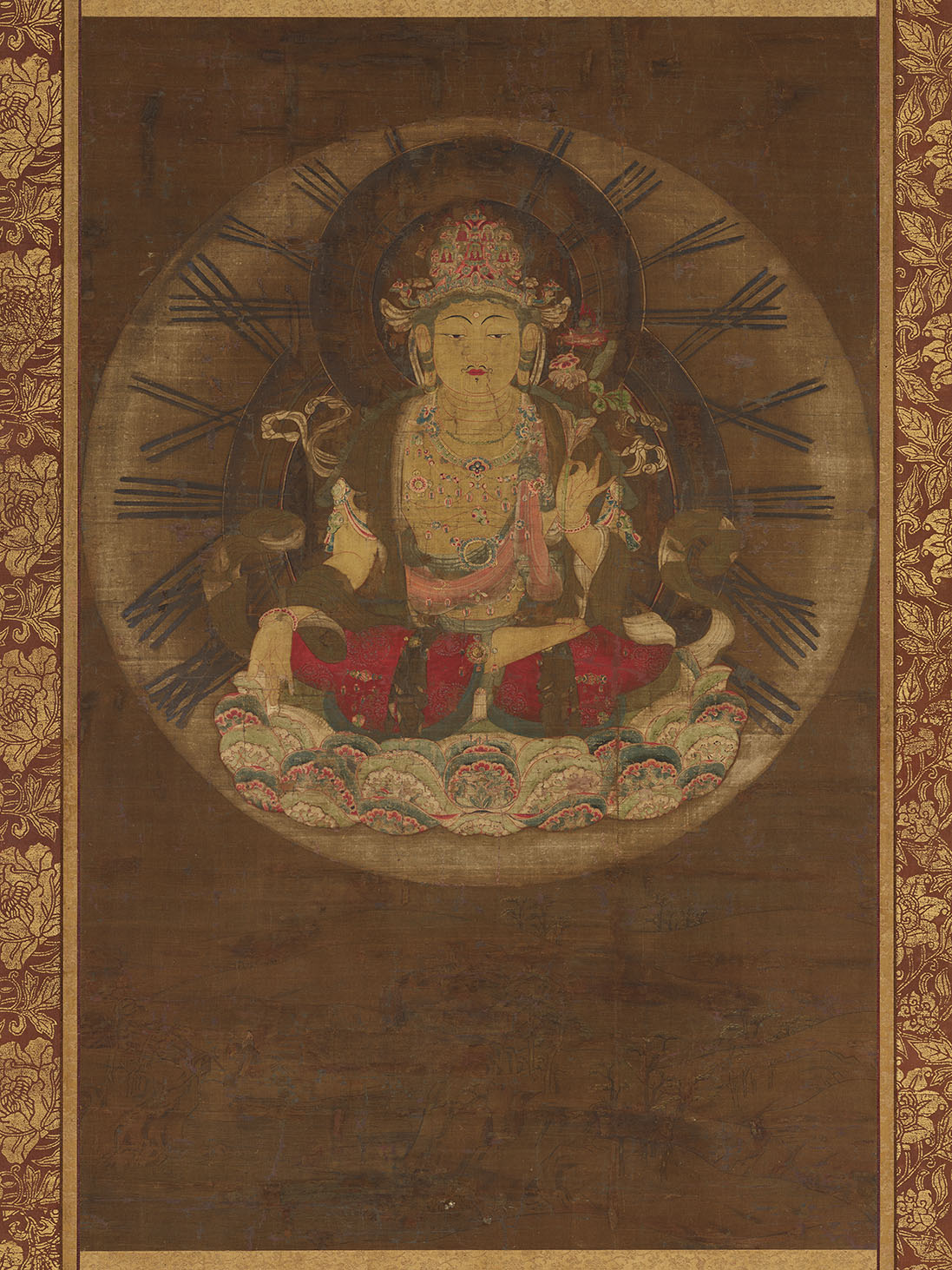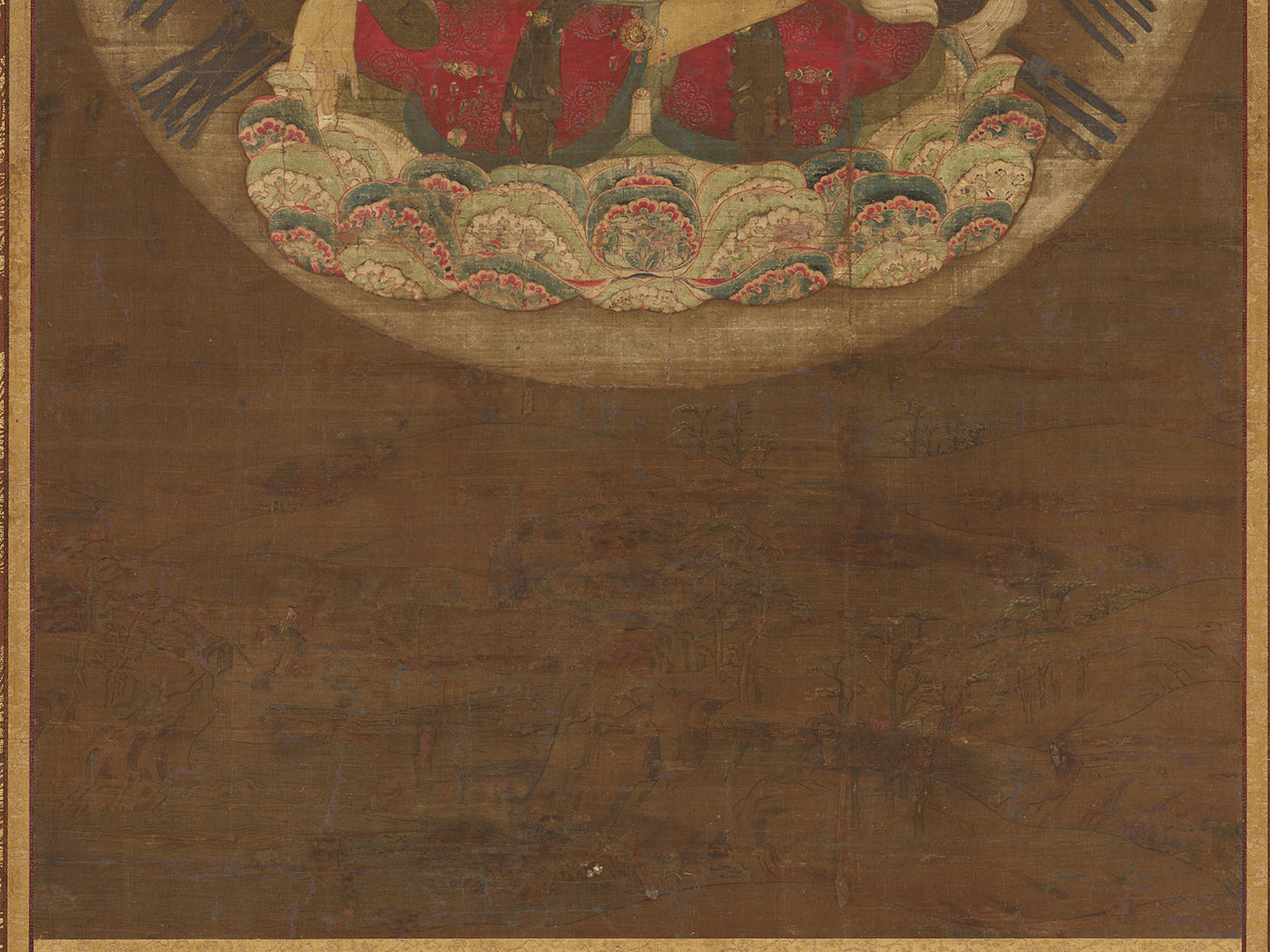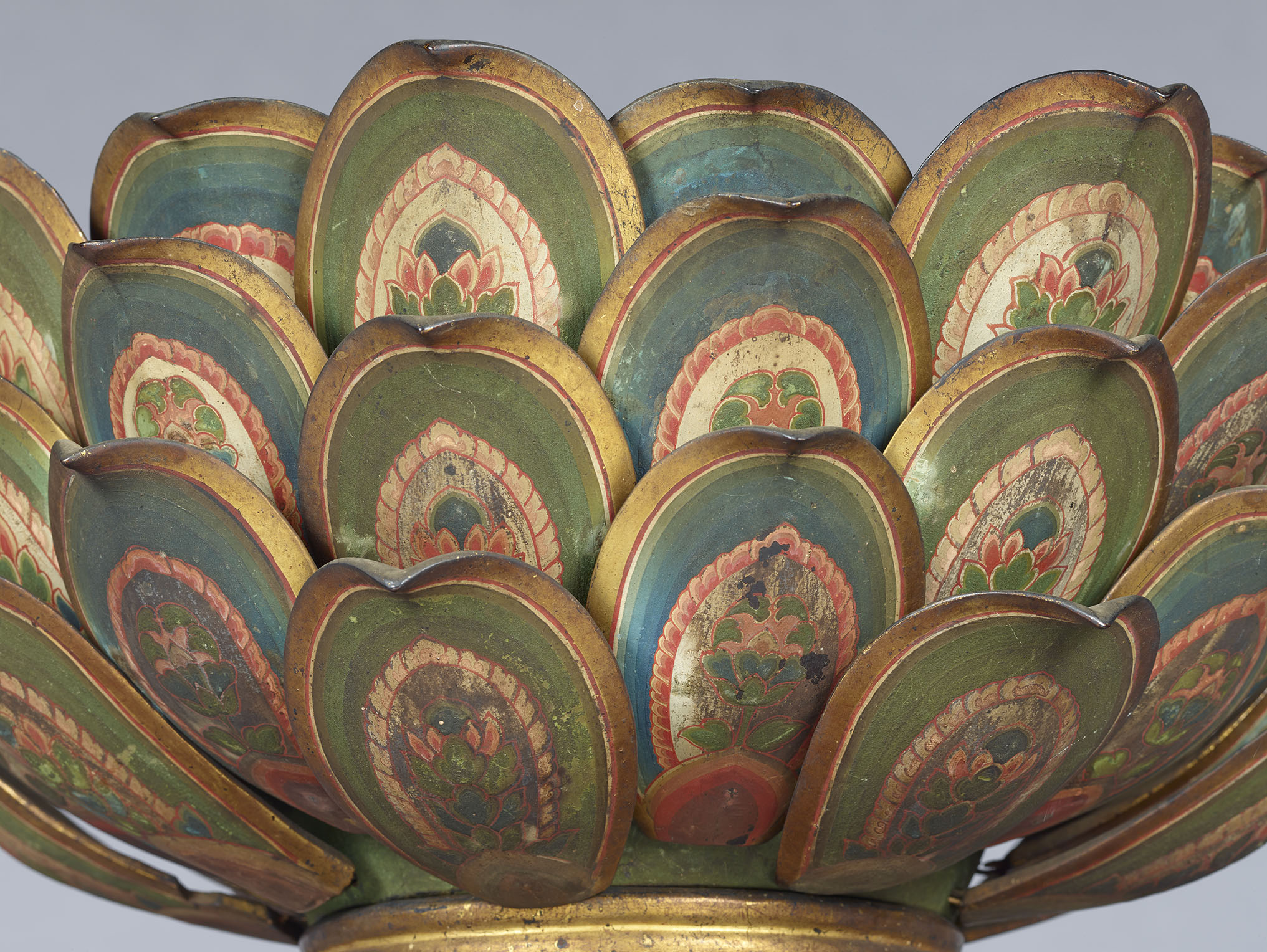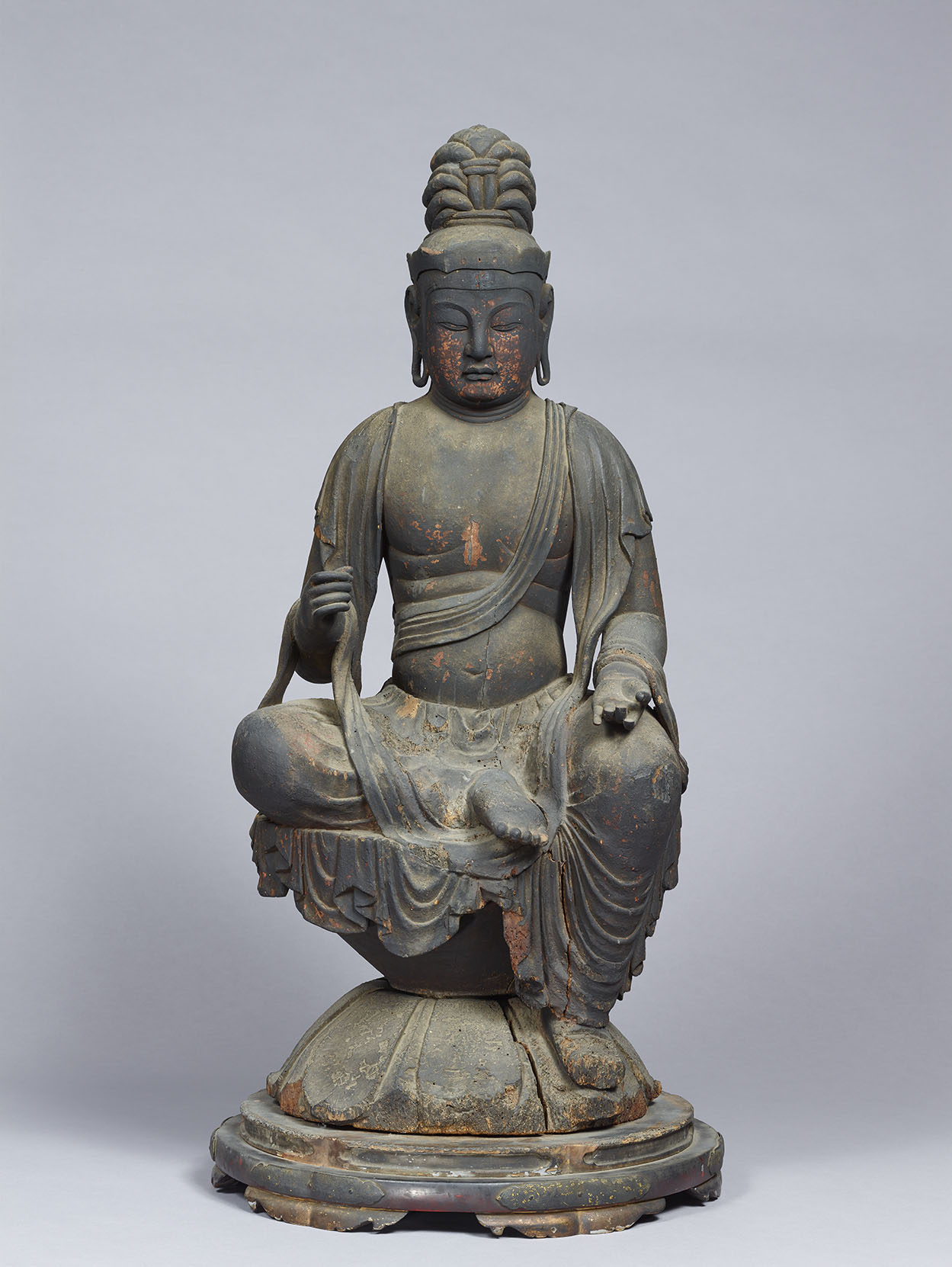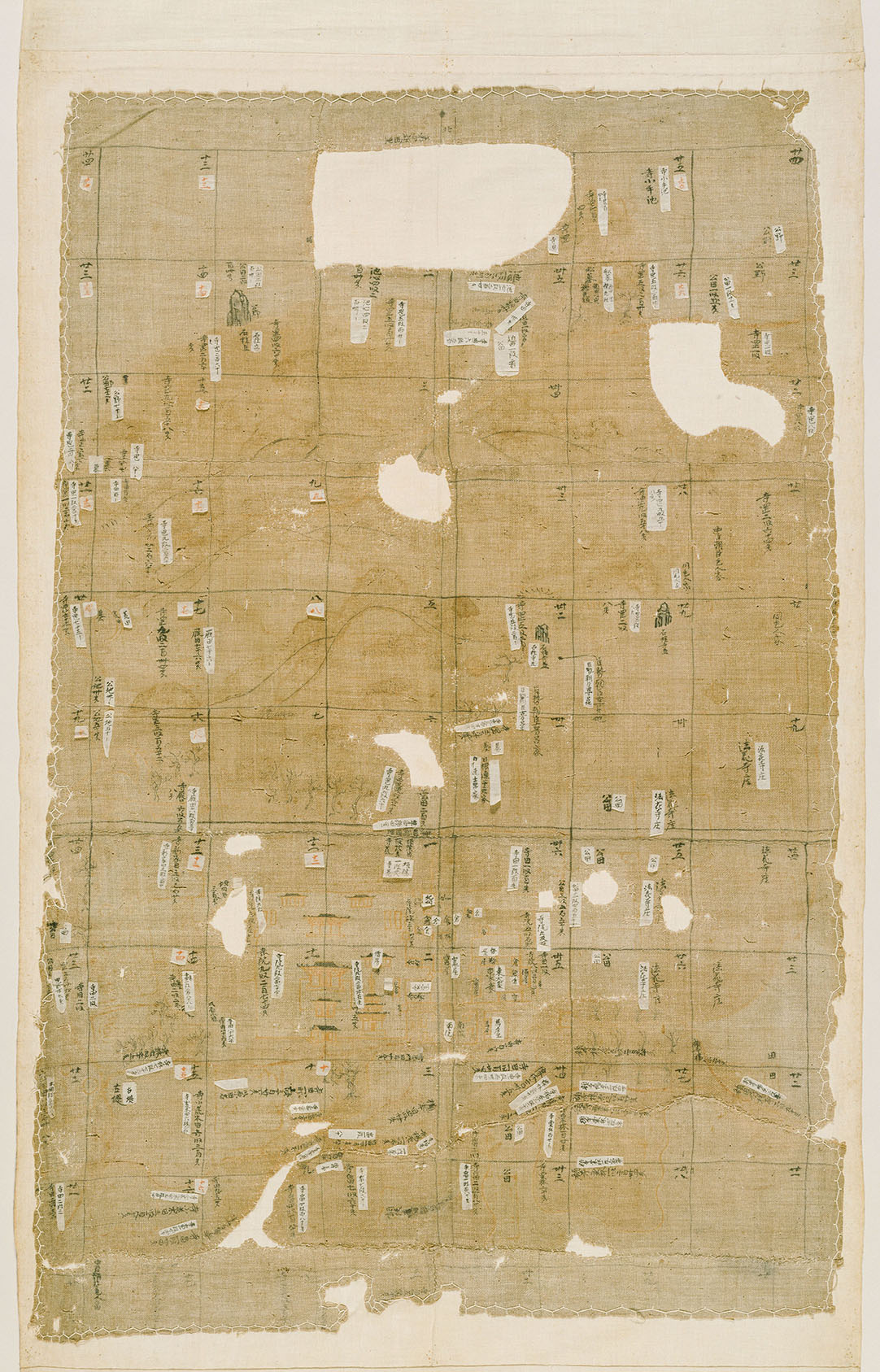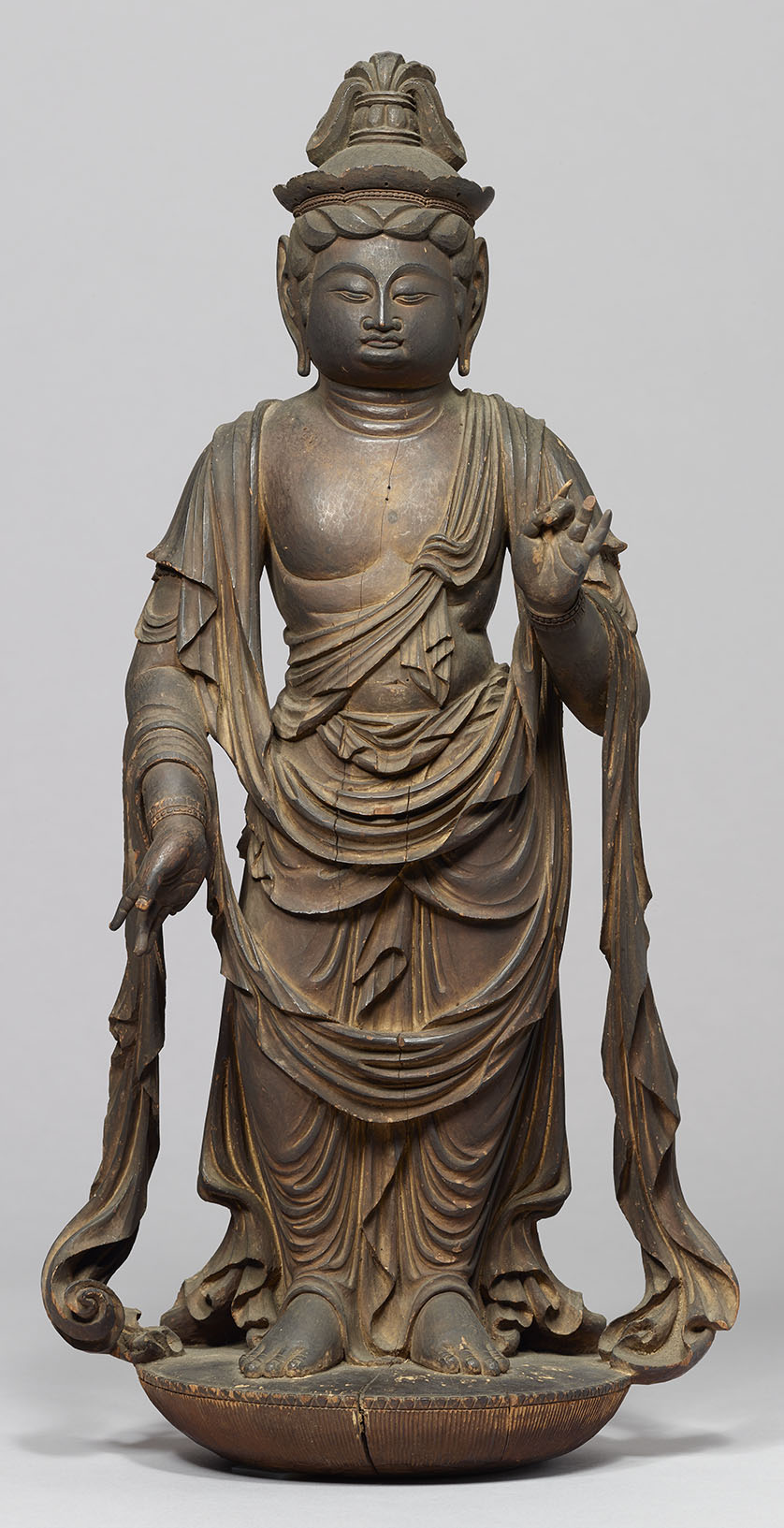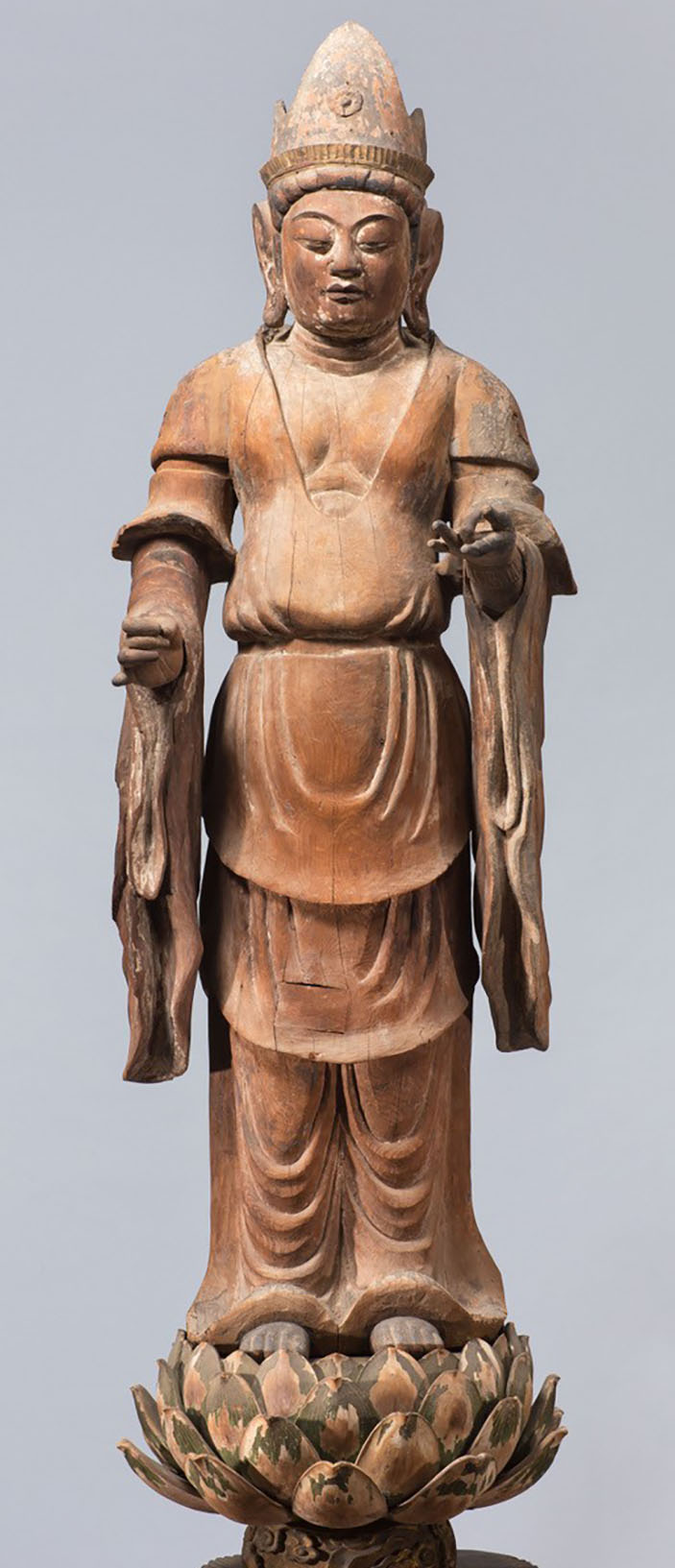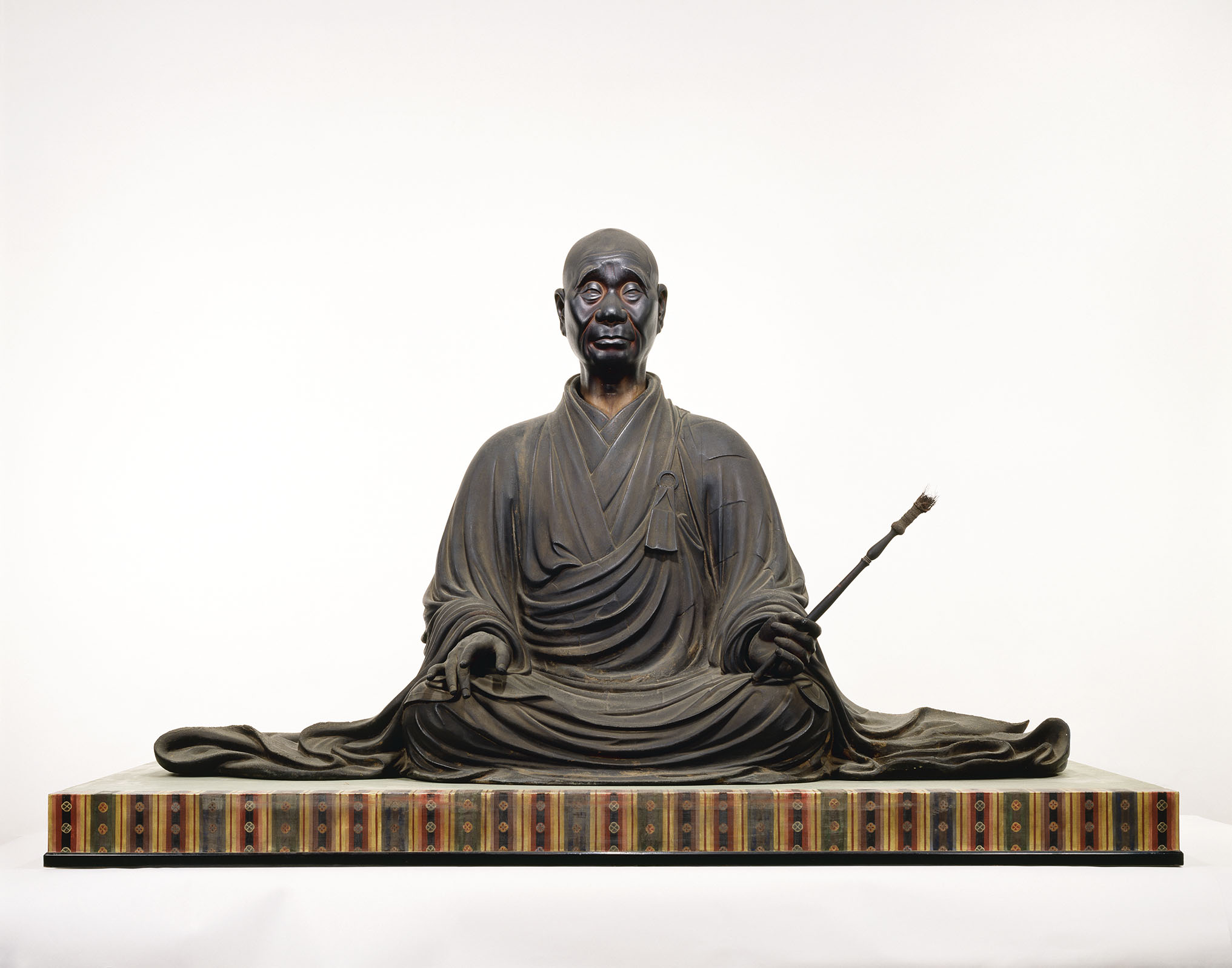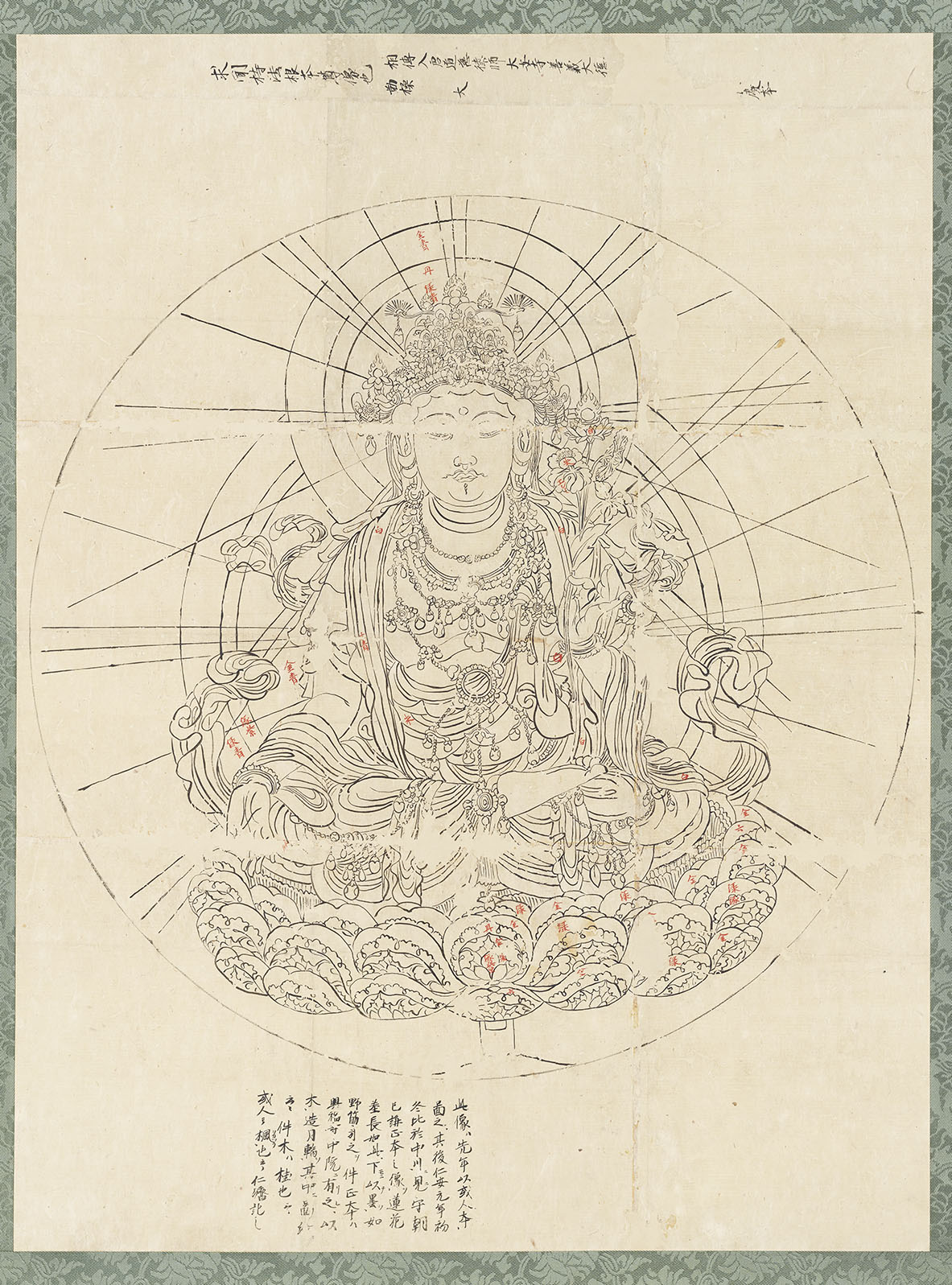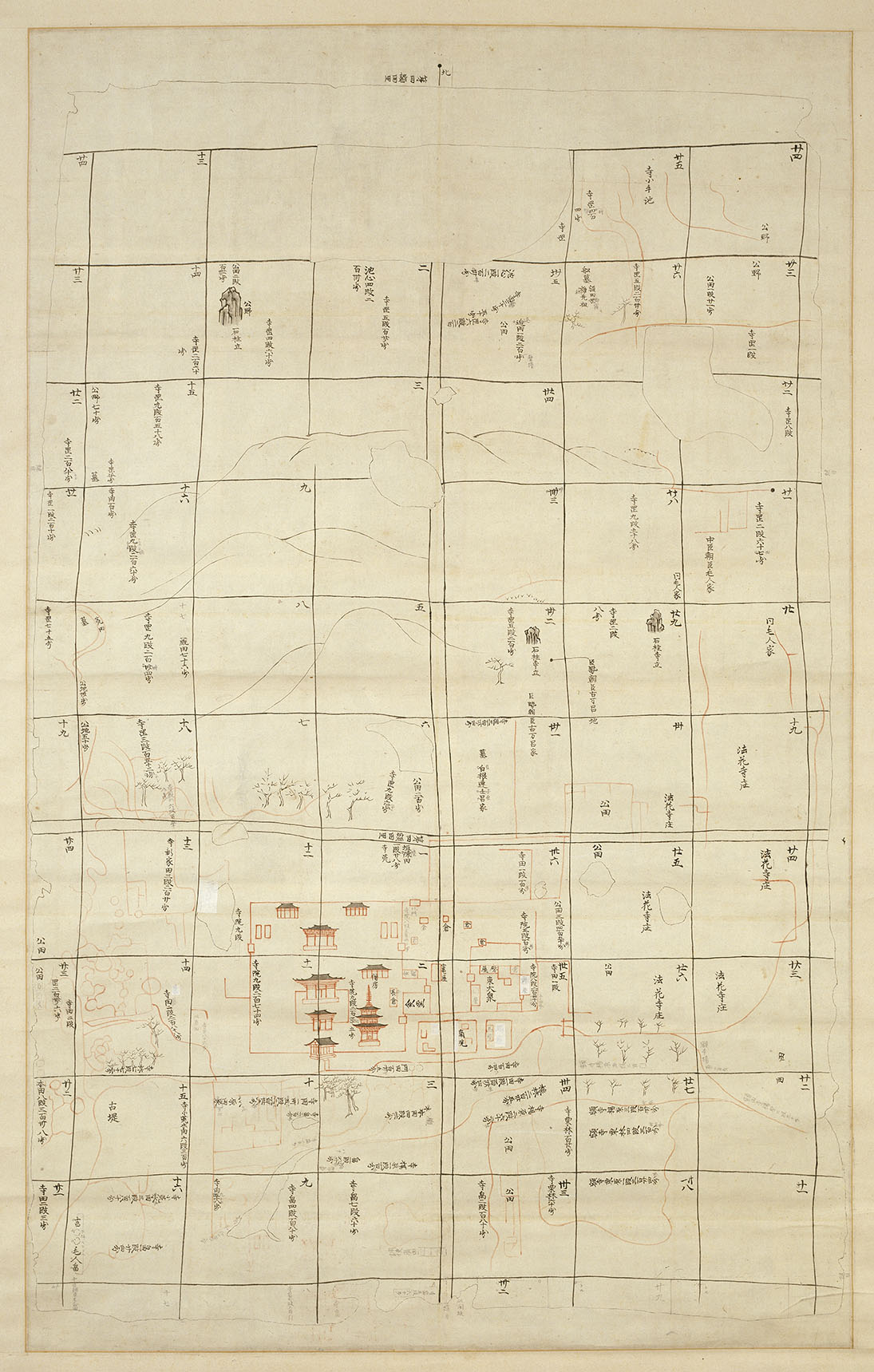Introduction
The late eighth-century sculpture of Kokūzō Bosatsu 虚空蔵菩薩 (Skt. Ākāśagarbha; Space Repository Bodhisattva) from Kakuanji 額安寺 in Nara sits upon a lotus pedestal inscribed with passages recounting different phases in the sculpture’s life (figs. 1, 2). The most prominent inscription, dated to Kōan 5 (1282), first states that the sculpture was the primary object of worship (honzon 本尊) for the eighth-century priest Dōji 道慈 (d. 744) in the gumonjihō 求聞持法, or ritual for memory retention. It then describes how the sculpture was neglected for five hundred years, but subsequently restored by two respected artisans and reconsecrated by the priest Eison 叡尊 (1200–1290). Another inscription, written below the thirteenth-century text, is from Meiji 12 (1879), and states that in this year, the then-head priest of Kakuanji reported the 1282 inscription to Home Minister Itō Hirobumi 伊藤博文 (1841–1909).1
Inscriptions on the base (uwagamachi) of Seated Kokūzō Bosatsu with One Leg Pendant (fig. 1)
These inscriptions reveal how this sculpture was conceptually reused in two different periods: first as a tool that, through memorial bonds with ancient priests and practices (as discussed by Fabio Gygi and Benedettea Lomi in this volume), legitimized Eison’s Buddhist activities; and later as a prime example of a Japanese Buddhist icon that was reframed as “art” during the Meiji period (1868–1912). The post-production repurposing of this sculpture imbued it with multiple meanings that highlight the importance and widespread practice of reuse in the Japanese Buddhist tradition, in addition to demonstrating the vital role of memory (real or imagined) in giving new value and purpose to objects across vast spans of time.
Focusing on the inscriptions, this article will first examine the eighth-century context of the sculpture, including its purported relationship to Dōji. I will then explore Eison’s connection to the sculpture, its thirteenth-century restoration and re-signification, and finally the importance of the 1879 inscription, remaining mindful of the importance of the sculpture’s materiality in each of its incarnations.
The Kakuanji Kokūzō Bosatsu and Its Inscription
Kakuanji is a Shingon Ritsu sect temple located in the small rural city of Yamatokōriyama in Nara Prefecture. According to the temple, the Kokūzō Bosatsu sculpture (an Important Cultural Property) was the primary image in the Main Hall from the Heian through Muromachi periods. In the Edo period, it was replaced by a Jūichimen Kannon 十一面観音 (Eleven-Headed Kannon) sculpture and moved to a less conspicuous corner of the building.2 It was housed in a small Kokūzō Hall by at least 1897, the year the temple submitted a list of its holdings to the Meiji period government.3 The sculpture came under the ownership of the Agency for Cultural Affairs in 2015 and has been housed at the Nara National Museum since then.
Based on its stylistic features and production method of dry lacquer over a wood core, the sculpture is dated to the late eighth century.4 It is a small image; together with its base and mandorla, it measures approximately 98 centimeters tall. The deity sits atop a multilayered lotus pedestal with the right leg folded in toward the body and the left leg pendant. The stem of a lotus bud is held delicately between the thumb and first finger of the right hand, while the other three fingers extend upward. The deity’s left hand sits palm-side up on the left thigh, perhaps in a modified version of the “giving” mudrā.
The somewhat squarish face has narrow, slightly downcast eyes, thin, arching brows, and a straight nose with small, flaring nostrils above a small, tense mouth. These stylistic features resonate with those seen on the mid-eighth-century Bonten 梵天 (fig. 3) and Taishakuten 帝釈天 sculptures, both National Treasures made of dry lacquer, housed in the Tōdaiji Hokkedō.5 The contours of the body are hidden by jewelry and fabric, but a slightly puffed chest, tapered and somewhat elongated torso, and straight back are visible. The skin is painted a dark pinkish hue with some blackened patches. Exquisitely rendered drapery comprises a shawl hung loosely about the shoulders, a sash tied diagonally across the torso, and a skirt-like garment on the lower body. Roundels of red and green with gold trim, although partly obscured by dust and grime, are still visible on the drapery. The folds of the skirt appear stiff and stylized in contrast with the smooth, flexible folds of the sash, while the squared, stiff feet protruding from beneath the skirt contrast with the delicately expressive hands. Removing the crown (a later replacement) reveals well-preserved blue pigment on the surface of the combed hair piled atop the head, secured in the center with a simple red ornament (fig. 4). Necklaces and arm adornments feature Chinese arabesque patterns and flower-shaped medallions covered with gold leaf. While the sculpture itself dates to the late eighth century, the pigment and gold leaf are thirteenth-century restorations.
Detail of Seated Kokūzō Bosatsu with One Leg Pendant, Kakuanji (fig. 1)
The mandorla and base are two components of the physical framing structures of the sculpture that function not simply as decoration, but as accessories to help re-create the realm in which a Buddhist deity exists; ritual activity is directed toward the entire set of objects.6 The large mandorla is one of the most striking components of the sculpture, with its intricately painted designs and delicate metal fittings. The compact yet detailed lotus pedestal comprises four sections: on top is a lotus with four layers of petals unfurling upward; each petal has a green-and-red flower painted on a white ground, surrounded by a ring of red-and-pink flame-like shapes, an outer layer of verdant green, and gold trim. The mid-thirteenth century Kokūzō Bosatsu painting at Fujita Art Museum in Osaka (fig. 5) has an almost identical decorative composition in the lotus petals (fig. 6) when seen together with the base of the Kakuanji sculpture (fig. 7). The placement of each painted flower at the bottom of each sculpted petal gives the impression of layers of petals and flowers emerging from the same source in multiple dimensions. Below the flower is a plump, cushion-like component with large bean-shaped motifs. This rests upon an inverted lotus flower, which in turn sits on a base of two stacked, scallop-edged disks. The top disk, smaller than the bottom, carries the inscription. All portions of the base and mandorla are made from Japanese cypress except the cushion-like component, which is made of Japanese Judas tree.7 Lifting the inverted lotus reveals the following inscription from 1282 (Kōan 5) on the top surface of the upper disk (fig. 2):
Detail of Kokūzō Bosatsu, Fujita Art Museum (fig. 5). Courtesy of Nara National Museum
Detail of Seated Kokūzō Bosatsu with One Leg Pendant, Kakuanji (fig. 1)
In short, the inscription identifies the sculpture as Kokūzō Bosatsu and explains its ritual function and relationship to the priest Dōji, followed by its restoration and reconsecration in the thirteenth century. Below, I examine this inscription in detail to illuminate the role of Kokūzō Bosatsu in premodern Japan, the sculpture’s connections to Dōji and Eison, and, more broadly speaking, the ways in which the inscription’s historical narrative reveal how the sculpture was given new meanings in different periods. The Meiji-period inscription, written below this primary one in a looser script, will be discussed later.此虚空蔵菩薩者道慈律師本尊也。
道慈律師者添下郡住額田氏人也。
入唐求学之時随善無畏三蔵伝虚空蔵求聞持法帰朝之後授善義護命勤操弘法流通此□□□
此本尊者被安置於彼氏寺額田寺径五百有餘歳之間形体損壊唯全御体依之御光寳冠所持物者佛師善春法橋更造加之御彩色者絵師明澄法橋御身并御座等忠8如本色奉彩色之然間弘安五年午壬十一月一日修補終功同二日西大寺上人叡尊被開眼供養之
弘安五年 午壬 十一月二日記之
This Kokūzō Bosatsu was the primary object of worship for Dōji (of risshi rank).
Dōji (of risshi rank) was of the Nukata clan in Soejimo-gun
While studying in China, he followed the Tripitaka master Śubhakarasiṃha, who transmitted the Kokūzō gumonjihō to Dōji. Upon returning, he transmitted it to Zengi, Gomyō, Gonsō, [and] Kūkai who spread it widely [illegible].9 This image was housed in his clan temple of Nukatadera.
Over the course of more than five hundred years, it became completely damaged. Because only the main icon remained, the hokkyō [rank] Buddhist sculptor Zenshun restored the sculpture, its mandorla, and attributes. The hokkyō painter Myōchō painted it, and the sculpture and base were both returned to their original state.
The repairs were completed on the first day of the eleventh month of the year Kōan 5 [1282]. On the second day of the same month, the priest Eison from Saidaiji conducted the eye-opening ceremony. Recorded on the second day of the eleventh month of Kōan 5.10
The Inscription: Identifying Kokūzō Bosatsu
The first line of the main inscription reads: “This Kokūzō Bosatsu was the primary object of worship for Dōji (of risshi rank).”11 Here it is clear that at the time the inscription was written the sculpture was identified as Kokūzō Bosatsu, the Japanese translation of the Sanskrit “Ākāśagarbha,” a compound of the Sanskrit terms ākāśa (space, ether, void) and garbha (repository, storehouse, matrix). The garbha encompasses boundless Buddhist merit, and Ākāśagarbha provides infinite meritorious benefits to all living beings from his own limitless repository. Fifth- and sixth-century Chinese sutra translations, ritual manuals, and commentaries emphasize his protective, redeeming, and prosperity-inducing powers, as well as his ability to eliminate hindrances to enlightenment, a feature especially relevant to Japanese Esoteric practice. It is difficult to ascertain when canonical texts related to Kokūzō Bosatsu entered Japan, but records of sutra copying reveal that such texts were circulating there at least by the second quarter of the eighth century.12 These are considered proto-esoteric texts that were incorporated into later, more established Shingon and Tendai Esoteric schools. Both painted and sculpted images of the deity appear in China, Korea, and Japan in single and group form during the eighth century; from the ninth century, configurations of Godai 五大 (Five Great) Kokūzō Bosatsu become focal points for national protection rites in Japan.
The sculpture has the basic iconographical features of many other bodhisattvas, such as princely garb, long hair, jewelry, and a crown. However, the attributes held by the deity may be either a long-stemmed lotus (either plain or topped by a “wish-fulfilling” jewel), a sword (a symbol of wisdom that is sometimes flaming or jeweled), or even a miniature stupa. The hand not holding an attribute typically performs the giving mudrā, with hand held downward and palm open. The iconography varies depending upon context, but when consistently identified, the attributes and mudrās generally convey a message of wisdom, compassion, or the fulfillment of wishes. However, the generalized and nonspecific iconography of this deity makes it easy to misidentify, or even to re-identify, an issue to be explored in depth below. Eighth- and ninth-century sculptures that have been identified as Kokūzō Bosatsu include the Important Cultural Property housed at Yatadera Kitasōbō (fig. 8), located a few kilometers away from Kakuanji in Yamatokōriyama;13 the seated image from Nōmanji in Iwaki, Fukushima Prefecture;14 and another seated image from a private collection.15 By the ninth century, sculpted and painted images of Kokūzō Bosatsu appeared in a variety of configurations.16
We also learn from the opening line of this inscription that this Kokūzō Bosatsu sculpture functioned as a honzon for the priest Dōji, immediately connecting its ritual function to an eminent priest.
Dōji and Kakuanji
The next part of the inscription reads: “Dōji (of risshi rank) was of the Nukata clan in Soejimo-gun.” Here Dōji’s priestly rank is repeated, and we learn of his clan and its geographic association, establishing Dōji’s familial prominence. The powerful Nukata 額田 clan was based in Soejimo County of Yamato Province (present-day northwest Nara Prefecture) and was known for furthering diplomatic ties between the Yamato region, China, and the Korean peninsula.17 Kakuanji was originally known as Nukatadera 額田寺, a direct reference to the clan name, but Dōji changed the temple’s name to Kakuanji.18 It is unclear exactly when the change took place, as the nomenclature of the temple is inconsistent in historical records that refer to the eighth-century site.19
Dōji was a prominent authority on Buddhist matters, having spent seventeen years studying in China. Years after his return to Japan, he was asked by Emperor Shōmu 聖武天皇 (r. 724–749) to revive the Sanron sect temple of Daianji in Nara. Dōji also held an advisory role to Tachibana Michiyo 橘美千代 (d. 733), mother of Empress Kōmyō 光明皇后 (701–760), showing his further links to Buddhism and authority in the Nara period.20 It is thought that Dōji lived at Kakuanji during the last years of his life, after spending most of his time at Daianji.21
Kakuanji was built on the site of the defunct Kumagori Dōjō, a small Buddhist practice hall belonging to the imperial regent Shotoku Taishi 聖徳太子 (574–622). The eighth-century Nukatadera garan narabini jōrizu 額田寺伽藍並条里図 (Plan of Nukatadera temple layout and surroundings; fig. 9), a National Treasure and a rare example of a temple map from this period, is an ink-and-color drawing on hemp of the temple grounds. It shows that during the eighth century Nukatadera had a Golden Hall in the center, a lecture hall to the north, monks’ quarters to the northeast, a three-storied pagoda to the southeast, a storehouse and eating hall to the east, and a middle gate and main gate to the south.22 This is typical of eighth-century Japanese temple layouts. It is unclear in which building the Kokūzō Bosatsu sculpture may have been housed, if it had indeed been created by the time this map was drawn.
While it is clear that Dōji had direct ties to the reputable Nukatadera/Kakuanji, problems arise when trying to link Dōji with this particular Kokūzō Bosatsu sculpture. Until the mid-eighth century, Buddhist sculptures were typically made of bronze, clay, or dry lacquer; the technique of wood core and dry lacquer used on the Kakuanji sculpture became common only during the latter half of the eighth century, that is, after Dōji’s death in 744. Creation of such a well-rendered sculpture using this relatively new technique is unlikely to have happened during Dōji’s lifetime.23 Furthermore, the connection between Dōji and the gumonjihō, the rite for which Kokūzō Bosatsu serves as a honzon, is also tenuous.
The Gumonjihō
The inscription continues: “While studying in China, he [Dōji] followed the Tripitaka master Śubhakarasiṃha, who transmitted the Kokūzō gumonjihō to Dōji. Upon returning, he transmitted it to Zengi, Gomyō, Gonsō, [and] Kūkai, who spread it widely [illegible]. This image was housed in his clan temple of Nukatadera.” Much of the cultural and religious importance of Kokūzō Bosatsu is tied to the deity’s role in a ritual called gumonjihō, or the memory-retention ritual. It is now generally categorized as an Esoteric ritual, although it was performed by priests affiliated with different sects throughout Japanese history. The priest Nichiren 日蓮 (1222–1282) is one example.24 The rite was performed to give priests the ability to remember the copious numbers of sutras and liturgical texts necessary for Buddhist practice. The full title of the ritual manual in which the procedure appears is Kokūzō bosatsu nōman shogan saishōshin darani gumonjihō 虚空蔵菩薩能満諸願最勝心陀羅尼求聞持法 (Rite for Seeking a Grip on What Is Heard, the Supreme Dharani for the Fulfillment of Desires of the Bodhisattva Ākāśagarbha25), which I will abbreviate as Gumonjiki.26 The gumonjihō is a physically and mentally demanding procedure that focuses on eidetic contemplations of Kokūzō Bosatsu. The first part of the ritual describes the honzon used in the rite as a painting of a golden Kokūzō Bosatsu seated in half-lotus position on a lotus throne in the center of a white moon disk. The face should appear peaceful and joyful, and in the deity’s crown are five Buddhas seated in full-lotus position. The deity holds a white or red lotus in the left hand; atop this lotus is a lapis-colored jewel with yellow light emerging from it. The right hand performs the giving mudrā, with the palm up and five fingers pointing downward.27
The ritual manual describes a painted image, but a fully sculpted image or even a round wooden or metal votive plaque could have been used instead. The iconography of the Kakuanji Kokūzō Bosatsu sculpture differs from this description: the hands holding the lotus and performing the giving mudrā are reversed, and the sculpture’s leg is pendant. Such discrepancies between written and visual depictions of Buddhist deities were not uncommon, but the anomaly could also indicate that the Kakuanji sculpture was not originally created as a Kokūzō Bosatsu sculpture.
The procedure continues: the practitioner finds a hut in a secluded, mountainous area and hangs the image on the wall facing west. An altar is constructed, on top of which offerings are placed. The deity is welcomed into the ritual space by a series of mantras and mudrās, but in order for the deity to appear, the practitioner must recite the dharani (merit-generating incantation) of Kokūzō Bosatsu one million times over a period of one hundred days.28 The mental and physical endurance needed to complete the rite is immense, and would require considerable knowledge and practical experience.
The standard narrative in existing scholarship purports that Dōji learned the gumonjihō from Śubhakarasiṃha and brought the ritual text to Japan when he returned from China in 718 (Kaiyuan 6).29 However, no corroborating eighth-century evidence exists that he did so.30 What is known is that in 701, Dōji joined a diplomatic embassy to Tang dynasty China, where he spent seventeen years studying Buddhist teachings, returning to Japan in 718.31 Śubhakarasiṃha translated Gumonjiki into Chinese in 717,32 which would have conceivably given Dōji approximately one year to learn the arduous rite while under his master’s instruction. It seems unlikely, however, that he would have been able to do so during his relatively short stay in China. In addition, while it was standard to compile inventories of objects brought by Japanese priests returning from China, no such inventory for Dōji exists. To date, the earliest source confirming Gumonjiki’s existence in Japan is the 737 record in the Shōsōin Documents (a collection known as Shōsōin monjo 正倉院文書) from Tōdaiji, twenty years after Dōji’s return.33 Zoku Nihongi 続日本記 records Dōji as having practiced this rite in 719, one year after returning to Japan, but this text was compiled in 797, over eighty years later.34 It is entirely possible that Dōji performed the rite later in his life, but it is doubtful that he performed it while in China or soon after his return; moreover, there is insufficient reliable evidence to prove that Dōji himself brought the ritual manual into Japan. However, historical memory, as the inscription shows, certainly wishes us to believe that a close connection existed between Dōji, this rite, and the Kakuanji Kokūzō Bosatsu sculpture.
Most research on this topic generally follows the gumonjihō transmission lineage mentioned in the Kakuanji inscription. However, had Dōji taught it to his disciple Zengi (729–812), the novice would have been younger than fifteen at the time; it is unlikely he would have been able to understand and master such a demanding rite at that young age. Priests such as Gonsō 勤操 (758–827), Gomyō 護命 (750–834), Kūkai 空海 (774–835), and Dōshō 道昭 (798–875) are also recorded as having practiced the rite,35 but the lineage transmission is unclear. The gumonjihō experience of Kūkai, patriarch of what is now known as the Shingon sect of Esoteric Buddhism, gets much attention in scholarship, primarily because of two documents recounting his early performance of the rite.36 The first, Sangō shiiki 三教指帰 (Demonstrating the Goals of the Three Teachings), purportedly written by Kūkai in 797 but described by Ryūichi Abe as a “quasi-autobiographical fiction,”37 states, “I met a Buddhist priest who instructed me in the meditative practice of Kokūzō known as gumonjihō.”38 Kawachi Shōen points out that Kūkai’s gumonjihō instructor is unnamed here, which obscures any ties to a transmission lineage.39 Another text, Kūkai sōzuden 空海僧都伝 (Biography of Kūkai), traditionally described as Kūkai’s final testimonial as recorded by one of his disciples in 835, also recounts Kūkai’s experience; while its authorship is unclear, the text is generally agreed to have been written prior to 857.40
In short, although the gumonjihō was likely practiced with some regularity by the latter half of the eighth century, its connection to Dōji, and even Kūkai, is tenuous. What is significant to this discussion, however, is that by the time the Kakuanji Kokūzō Bosatsu’s inscription was written in the thirteenth century, the narratives of early gumonjihō practitioners (especially Dōji and Kūkai) had been accepted as truth by its inscriber. The quasi-mythical nature of the connection between these priests and to the rites they performed presents a flexible and open origin story of the sculpture that allowed for its later reshaping and reframing through the careful curation of associated memories.
It is significant that approximately one-half of the inscription is devoted to Dōji’s biography. As Andrew Quintman explains, biographical inscriptions written on religious icons can “effectively enliven the image and mediate a relationship between the author, biographical subject, consecration master, and receiving community. As an elaborate description of a person’s life, the text—and the image it inscribes—are understood as person-like and therefore targets for and sources of social agency.”41 Dōji’s clan connections, his purported experience with the gumonjihō, and his relationship to the Kakuanji Kokūzō Bosatsu all serve to legitimize Eison’s claim to the ancient Buddhist-ritual past (real or imagined) that this narrative embodies.
Less attention is given to the other eighth- and ninth-century priests Zengi, Gomyō, Gonsō, and Kūkai in relation to the gumonjihō, but the mere mention of their names places them within the lineage of the ritual, beginning with Śubhakarashiṃha’s continental authority and ending with the creation and veneration of this sculpture in Japan. Rather than take this inscription as a document of the eighth or ninth centuries, it is better understood as what the thirteenth-century inscriber wanted us to believe about the eighth- and ninth-century history and function of the sculpture.
Five Hundred Years of Neglect
After describing the sculpture’s connection to Dōji, the inscription presents us with a five-hundred-year-gap in its history: “Over the course of more than five hundred years it became completely damaged.” The sentence seems innocuous, but this five-hundred-year gap raises important issues of reframing. We are confronted with a low point in the sculpture’s life, thrown into higher relief against the memory of the revered icon as the object of worship for Dōji’s gumonjihō practice. This lamentable period of neglect42 and resulting damage is a vital moment in the narrative; it sets the stage for the subsequent “rescue” of the Kakuanji Kokūzō Bosatsu in the thirteenth century by Eison. The degree to which the sculpture was ignored and damaged may be exaggerated for rhetorical effect, but such exaggeration only serves to highlight further the outright necessity of the restorations and reconsecration that were vital for the future of the dharma as expounded by Eison. In a climate of ever-increasing sectarian competition, involvement in the restoration of a sculpture so revered in the memory of the Japanese Esoteric tradition (whether that memory was real or manufactured) legitimized the Esoteric aspects of Eison’s emergent Shingon Ritsu sect, as well as the reputation of the artists involved.
Restoring the Sculpture
Next, the inscription reveals how and by whom the sculpture was restored: “Because only the main icon remained, the hokkyō (rank) Buddhist sculptor Zenshun restored the sculpture, its mandorla, and attributes. The hokkyō painter Myōchō painted it, and the sculpture and base were both returned to their original state.” Here we learn the names and ranks of the artists Zenshun 善春 and Myōchō 明澄, who were responsible for the image’s much-needed restoration in the thirteenth century. The inscription states that they both held the title of hokkyō 法橋 (Bridge of the Law), one of three ranks awarded to Buddhist sculptors and painters. The bestowing of these ranks, a practice begun in the eleventh century, was akin to ordination.43 Zenshun (act. thirteenth century) was from the Zen 善 lineage of sculptors that also included the prolific Zen’en 善円 (1198–1256, known later as Zenkei 善慶). Both were involved in sculptural projects related to Eison and helped bolster the image of Saidaiji in the thirteenth century with their high-quality works.44 Zenshun had close ties to Kōfukuji, Kasuga Shrine, and the Ritsu monks at Saidaiji who promoted the Buddhist precepts as well.45 Zenshun’s name appears in many temple records; he is perhaps best-known for Eison’s portrait sculpture at Saidaiji (fig. 12).
Regrettably, little is known about the painter Myōchō. However, because it was common for painters of Buddhist two-dimensional works to also paint Buddhist sculptures,46 comparing sculptures with contemporary paintings may provide information about artistic lineages, at the very least. Comparing the lotus-petal base of the mid-thirteenth century painting of Kokūzō Bosatsu at Fujita Art Museum in Osaka with the petals of the Kakuanji sculpture’s lotus base—which, we will be reminded, was repainted in the late thirteenth century—reveals a similar central leaf motif surrounded by a red-and-pink flower-like border on a blue ground rimmed with gold (fig. 6). I will not attempt to attribute the painting’s creation to Myōchō, but the compositional similarities between the two flowers could indicate that Myōchō was in a similar artistic lineage as the artist of the painting, an issue that invites further research.
In sum, this part of the inscription informs us of the sculpture’s physical restoration by sanctified artists, adding another layer of sacrality to the sculpture. In its physical restoration, we are reminded of the sculpture’s materiality and taken back to the five-hundred-year period of neglect that necessitated the repairs.
Furthermore, because so little eighth-century documentation related to the Kakuanji sculpture remains, and because of the somewhat vague iconography of Kokūzō Bosatsu images in general (discussed above), at present there is no way to know if this sculpture was created as an image of Kokūzō Bosatsu. Re- or misidentification of Kokūzō Bosatsu sculptures is common. For example, a ninth-century wooden sculpture (designated as a National Treasure) housed at Daigoji that was known for many years as an image of Shō Kannon47 was officially re-identified as Kokūzō Bosatsu in the Japanese National Treasure registry in 2015 (fig. 10).48 Another eighth-century sculpture that has, throughout its lifetime, been identified as both Kokūzō Bosatsu and Monju Bosatsu 文殊菩薩 is located at Nōmanji Temple in Fukushima Prefecture.49 The tenth-century sculpture currently identified as Kokūzō Bosatsu (an Important Cultural Property) housed at Kōonji in Osaka has also likely undergone a re-identification, indicated by its iconography, which is more consistent with Kichijōten 吉祥天 than Kokūzō Bosatsu (fig. 11).50
Re-identification and re-signification of icons is not uncommon in the history of Japanese Buddhist sculpture. Examples include the ninth-century sculpture of Yakushi Nyorai 薬師如来 in the Murōji Golden Hall, which, with a change in the iconography of the hands, became a Shaka Nyorai 釈迦如来 sculpture in the beginning of the eighteenth century.51 Another example is a sculpture at Daitokuji 大徳寺 that in the nineteenth century was changed from a portrait of the priest Ten’yū Shōkō 天祐紹杲 (1586–1666) into one of the priest Shōkei Jōfu小渓紹怤 (1475–1536) when the head portion of the sculpture was switched.52 The Kakuanji sculpture shows no sign of having parts being switched out, but it and the above examples illustrate that Japanese temple tradition has, Greg Levine notes, “prompted us to view Buddhist images as knotted tightly into the weave of an enduring historical fabric. Nevertheless, it is abundantly clear that this fabric has been torn at times, patched, and even rewoven.”53 Once these icons underwent physical changes, they were re-identified and reused for different ritual purposes, thus gaining a new meaning within the Japanese cultural and religious landscape. It is precisely the material transformations that constitute the conceptual changes in the sculptures.
It is not possible to determine whether the Kakuanji sculpture was originally intended to represent Kokūzō Bosatsu or another deity, but the thirteenth-century restorations and inscription assert its identity as a Kokūzō Bosatsu, as well as that of a bridge between memories (whether real or imagined) of the eighth-century past and the thirteenth-century present of Eison. The repairs, reconsecration, and reframing of the Kakuanji sculpture in the thirteenth century are rendered all the more valuable set against the five-hundred-year period of disuse and negligence noted in the inscription. This period also provided an opportunity to create a narrative that reframes the sculpture in connection with Eison, the savior of the sculpture. As Richard Davis remarks, in Buddhism memories have been “periodically reembodied in new narratives, and these narratives have never been transparent renderings of fact nor innocent of larger agendas.”54 In establishing a bond between Dōji and Eison, the icon was repurposed to legitimize the latter’s religious authority based on the memories of the ancient and therefore “pure” Esoteric traditions that Kokūzō Bosatsu elicits.
Eison and the Eye-Opening Ceremony
This brings us to the last section of the inscription that connects the icon to Eison: “The repairs were completed on the first day of the eleventh month of the year Kōan 5 [1282]. On the second day of the same month the priest Eison from Saidaiji conducted the eye-opening ceremony. Recorded on the second day of the eleventh month of Kōan 5.”
Before considering why Eison conducted the eye-opening ceremony on this particular sculpture, the significance of the rite itself requires explanation. The particular procedures and meanings may differ according to a given region, period, or sect, but in general, Japanese Buddhist sculptures undergo a consecration ceremony known as kaigen kuyō 開眼供養 or kaigen-e 開眼会 (lit., “eye-opening ceremony”), in order to transform an object into an icon.55 Alfred Gell describes such consecration rites as “the management of the transition between the religious image as a mere manufactured thing and a vehicle of power, capable of acting intentionally and responding to the intentions of the devotees.”56 In the Japanese Esoteric tradition, the priest’s role in consecrating the image is central; the officiant visualizes the deity and then projects the visualization onto the sculpture or painting. Thus the icon is thought to become enlivened as a result of an interchange among the priest, the deity, and the image.57
Conversely, a sculpture may also be deconsecrated in a ritual known as hakkenshiki 撥遺式,58 whereby the spirit (Buddha essence) is removed,59 a subject explored by Benedetta Lomi in this issue. This is done when an icon is removed from its worship context for repair, examination, or exhibition in a museum. The ritual effectively turns the icon into an inanimate object so that it may be handled. Afterward, when the image is ready to be returned to its worship context, a new eye-opening ceremony is performed to re-imbue it with sacredness. The extent to which the original consecration ceremony and reconsescration ceremony are similar is unclear. The Kakuanji sculpture may have undergone such a deconsecration ceremony before it was restored, or perhaps the five-hundred-year period of negligence automatically “erased” the presence of the deity. In either case, a reconsecration ceremony (performed by Eison) was deemed necessary after the sculpture was restored. This reconsecration and physical repair not only restored it as a functioning honzon, but also repurposed the sculpture as a tool to legitimate Eison’s ties to older Esoteric traditions that were embodied in the Kakuanji sculpture’s narrative.
Eison’s involvement with Esoteric teachings is evident early in his career. He first studied Buddhism at the Shingon centers of Daigoji in Kyoto and Kongōbuji in Wakayama prefecture before moving to Saidaiji in Nara in 1235. Here he established his own order of Buddhism based on the Shingon and Ritsu (“precept school”) teachings. He did so primarily because he questioned the validity of standard ordination practices at this time and was dissatisfied with the laxity with which contemporary clerics adhered to the Buddhist precepts. This was part of a thirteenth-century trend of “precept revival” that occurred across denominational lines.60 Eison also admired Kūkai because of their shared emphasis on upholding monastic precepts.61
Kakuanji’s connection to Shōtoku Taishi may have been what drew Eison to the temple; as mentioned above, it was built on the site of Shōtoku’s meditation hermitage, a fact of which Eison must have been aware. As a social activist, he admired and strove to emulate Shōtoku’s efforts to help those in need; sites affiliated with him are often mentioned in Eison’s writings.62 More specifically, there was an outcast community on the west side of Kakuanji that by at least 1240 was attended to by Eison’s disciple Ninshō 忍性(1217–1303).63
Eison’s visit to Kakuanji is corroborated in his biography titled Kongō busshi kanshingaku shōki 金剛仏子感身学正記 (Record of How the Adamantine Child of the Buddha [Eison] Physically Responded to the Buddha and Studied the Correct Doctrine64), compiled in 1285–86. The entry for the first day of the eleventh month of 1282 states that he visited the site;65 this was likely the occasion of the eye-opening ceremony. Eison was connected with Kokūzō Bosatsu images in other contexts as well: for example, he held national protection rites at Saidaiji that incorporated images of the Godai Kokūzō Bosatsu,66 thus demonstrating his belief in the deity in multiple configurations.
Other evidence connects Eison to the Kakuanji sculpture. For example, Zenshun, the sculptor mentioned in the Kakuanji inscription, also created Eison’s 1280 portrait sculpture (a National Treasure) housed in the Aizendō of Saidaiji in Nara (fig. 12).67 Furthermore, through the collaborative efforts of Eison, his disciple Ninshō, and the Kakuanji head priest Gakushun 学春 (dates unknown), the temple joined the Shingon Ritsu sect based at Saidaiji.68 The relationship continued into the next generation; Ninshō first studied Buddhism at Kakuanji in 1232 at the age of sixteen. Iwai Tomoji speculates that he used the icon in the gumonjihō at this time (in its unrestored state) and must have been moved by the newly restored image when he visited the temple as an elderly priest.69
Eison certainly had specific reasons for associating himself with this diminutive sculpture and its temple, but his actions are part of what appears to be a twelfth- through fourteenth-century “revival” of Kokūzō Bosatsu—related objects and rituals. We see the deity emerge in Japan during the eighth and ninth centuries, but there seems to be a gap in Kokūzō-related activity during the tenth century, and a resurgence beginning in the mid-eleventh century that peaked in the mid-twelfth through fourteenth centuries. Many Kokūzō-related rituals were performed, and many paintings and iconographical drawings were produced.70 One example relevant to this study is a thirteenth-century iconographic drawing of Kokūzō Bosatsu currently housed at Daigoji in Kyoto (fig. 13). This image, an Important Cultural Property, depicts the deity seated in full lotus position inside a moon-disk. Written above the deity is an inscription that reads “picture of the main image for the gumonjihō” and states further that Dōji handed it down to his disciples Zengi and Gonsō. It is likely that this form was not yet standardized during the eighth or ninth century but was established later, in the twelfth or thirteenth centuries, and retroactively associated with Dōji to lend credence to the image. It is also worth recalling that Eison studied at Daigoji early in his career. Stylistic elements and motifs of the iconographical drawing are seen in contemporary paintings as well, revealing that by the thirteenth century a standard visual vocabulary had been set for the deity. Again, this inscription is better understood as revealing what certain thirteenth-century authors may have promoted, rather than actual eighth- and ninth-century lineages.
Why did medieval priests connect their objects to certain people and places of the past? The Kokūzō Bosatsu revival, including the issues surrounding the Kakuanji sculpture that I have highlighted here, point to an even larger movement on the part of temples to assert their identity and legitimacy during a period when priests from older Buddhist traditions competed with those from newer ones to garner imperial favor and patronage. The thirteenth century is commonly known as an active period for the spread of Buddhist sects like Pure Land and Zen, but there was also a trend—perhaps in reaction to the popularization of these more recent forms—toward the return to older elements and lineages, including Esoteric practices, in the Japanese Buddhist tradition.71 Eison’s brand of Shingon Ritsu teachings borrowed and reinterpreted older traditions;72 his involvement with the Kakuanji sculpture and the 1282 inscription exemplify the efforts at legitimization via their association with Dōji’s ancient Esoteric activities. The biography of the object is essential in this role because, as Chris Gosden and Yvonne Marshall explain, “the fame of objects and the renown of people are mutually creating, so that objects gain value through links to powerful people and an individual’s standing is enhanced through possession of well-known objects.”73 Exploring the accumulated memories of objects reveals the diverse social values that objects acquire through associations to those in control.74 The inscription tells us that the restoration and reconsecration of the sculpture transformed it from Dōji’s (unintentionally) desecrated honzon into a restored, newly sanctified icon associated with Eison’s sphere, where it served as an embodiment of ancient Esoteric practices and authority.
The sculpture’s new role allowed it to bring a certain amount of cultural capital to Eison’s Buddhist teachings via the memories it elicited. The value of this capital, however, was contingent upon the memory of Dōji. The factual circumstances connecting Dōji to this sculpture are tenuous at best, but I argue that even a constructed, apocryphal, imagined memory has the potential to be powerful.75 The cultural value of both the Daigoji iconographical drawing and the Kakuanji sculpture rely upon the memory of past priests. When an object is reframed and re-signified, the memory value of its past form (whether real or imagined) adds and in some cases is essential to the value of the new thing. The memory carries the value from one form to the next. According to Allan Roberts, this is especially applicable to devotional images, as they “not only permit but provoke re-signification. . . . [The] sensory immediacy of popular, vividly colored images leads people to speak of a depicted deity’s efficacy, and link the origination of the image to their own biographies.”76
Reframing in the Meiji Period
Another inscription on the Kakuanji Kokūzō Bosatsu, written in small, loose script perpendicular to the thirteenth-century text, reads: “此御銘文明治明治十二年十一月卅日拝写上申内務府内務郷伊藤博文公也 額安寺住職訓導額田英慶記之生丗八” (On the thirtieth day of the eleventh month of Meiji 12 [1879], I reverentially transcribed this exalted inscription for a Home Ministry77 report to Home Minister Itō Hirobumi. Head priest of Kakuanji and elementary school teacher Nukata Eikei, aged thirty-eight).78 This inscription, largely ignored in existing scholarship, serves as a footnote explaining that on the thirtieth day of the eleventh month of 1879, Nukata Eikei 額田英慶, who was then head priest of Kakuanji, transcribed (that is, onto another document) the 1282 inscription and reported it to Itō Hirobumi. Investigating the circumstances of this transcription helps us understand how it served again to reframe and repurpose the sculpture in the Meiji period, and the conditions under which the meaning of this sculpture was drastically transformed while still retaining “threads of earlier meanings”79 vital for understanding the sculpture’s significance.
When Japan’s period of national isolation ended and the Meiji Restoration began in 1868, the country was presented with an opportunity to reframe a Japanese identity that could be asserted on the worldwide (specifically Euro-American) stage. This momentous shift in the fabric of Japanese society was somewhat akin to the five-hundred-year gap in the Kakuanji sculpture’s history, in that it provided an opportunity for the sculpture to be reused in a different context. In the 1870s, intellectuals and government officials promoted Euro-American-based science and technology and proceeded to influence government policies regarding how Japan should advance its “modernization.” Separation from China and India were key in this early stage of identity formation,80 and as a result, “native” Shinto became the dominant state-sponsored ideology of the public, secular realm, while “foreign” Buddhist belief and practice were relegated to the private, sacred realm.81 For centuries prior, Japanese religion had been a complex synthesis of Buddhist, Shinto, Daoist, and Confucian elements, but this multimodal system with its “non-Japanese” aspects was considered inappropriate for a modern Japan. The years 1869–71 even witnessed a series of intense anti-Buddhist movements in Japan, represented by the infamous slogan haibutsu kishaku 廃仏毀釈 (destroy Buddhism and kill Śākyamuni),82 during which many Buddhist temples and icons were destroyed.
By the late 1870s, anti-Buddhist activities had waned, but in order to survive in the new era, priests and other intellectuals were now tasked with reframing the history, beliefs, and practices of Japanese Buddhism in ways that were acceptable on the international stage. For example, the term shūkyō 宗教 (religion) was coined during this time, partly in reaction to institutionalized concepts of “religion” that were entering Japan.83 Efforts to historicize the religion proved successful: by the 1880s, Buddhist institutions had expanded; and by the 1890s, remarks James Ketelaar, Buddhists sought “to inscribe their past in the collective cultural conscience of modern Japan.”84
Also realizing that it was beneficial to preserve historically and culturally valuable objects in the name of creating a Japanese national identity,85 the Meiji government promulgated the Laws for Preserving Antiquities (Kokikyū butsu hozon kata 古器旧物保存方) in 1871. In 1872 edicts were issued to mediate anti-Buddhist activity,86 and the Office of Exhibitions (Hakurankai jimukyoku 博覧会事務局) was established. The 1870s–90s saw the rise of public exhibitions and museums in Japan, along with the emergence of specialized terms such as such bijutsu 美術 (fine arts) and geijutsu 芸術 (art), which first appeared in documents classifying exhibits for the 1873 Vienna World Exhibition.87 Buddhist icons were removed from their temples, examined, catalogued, and evaluated so that the government could keep track of their whereabouts and condition. Some never returned to their homes and remain in museum care to this day. The relocation of religious icons into museums, which Michael Marra describes as “secularized versions of temples housing beauty,” may have saved them from physical destruction.88 However, as Pamela Winfield explains, this “new modern secular ideal required that these religious icons be stripped of their salvific power and appreciated based on Euro-American ideals of technical skill, precious materials, impressive provenance, historical significance, and well-preserved condition. . . . Japan was never fully colonized by foreign political powers, [but] this process of aestheticizing the icon did a certain colonizing violence to the Buddhist image.”89
In this context, the 1879 Kakuanji inscription takes on a fresh meaning. There is no record of the Kakuanji sculpture having been put on display at this time, but in 1879, the very year it was written, the Home Ministry required all temples and shrines to submit detailed records of their holdings. The list that Kakuanji submitted in 1879 includes the Kokūzō Bosatsu sculpture, housed at that time in a Kokūzō Hall.90 This was likely when the 1879 inscription was written by Nukata Eikei. Little is known of him, but his family name clearly indicates ties to the Nukata clan, the same clan to which Dōji belonged; the clan name itself elicits memories of Dōji and, by extension, of the ancient Buddhist practice of the gumonjihō. Itō Hirobumi is most notable for becoming Japan’s first prime minister in 1885, but prior to that role he served as home minister, or naimukyō 内務郷, a post within the ministry of state, from 1878 to 1880, during the period when the inscription was written.91 Considering the anti-Buddhist activities earlier in the decade, the inclusion of the sculpture in the register may have provided some peace of mind for the temple; it also, however, significantly dimmed the sculpture’s divine nature.
The 1879 inscription informs us of the second conceptual reuse of this icon in the Meiji period: as an object whose technical and aesthetic features were deemed worthy of recognition by the recently restored Meiji government. Thusly reframed, it became one of many symbols of cultural “heritage,” a socially constructed and historically contingent category in itself. The memories associated with the sculpture as an object of ancient worship practices, or later as a tool for the propagation of a new religious tradition, were reduced to historical anecdotes.
Interestingly, in the same year that the 1879 text was written on the sculpture, the eighth-century map of Kakuanji (see fig. 9) was copied by the Nara hakuran kaisha 奈良博覧会社 (Nara Exhibition Company),92 the precursor to the Nara National Museum, where the copy (fig. 14) is presently located. The reproduction of this rare eighth-century document, and the housing of this copy in a national institution, is yet another example of governmental assertion of control over the temple’s own history.
The physicality of the inscription itself is also significant; similar to the tradition of interring objects such as relics, ritual utensils, copies of sutras, dedications, and so on, the act of inscribing an icon connects not only the inscriber, but the people named in the inscription, to the icon, and by extension to the deity, in a physical, tangible manner. The inscriptions forge connections among Dōji, Eison, Zenshun, and Myōchō, and between Nukata Eikei and Itō Hirobumi, showing how the sculpture and its associated memories were repurposed in each respective period to legitimate certain forms of power. The Kakuanji Kokūzō Bosatsu and its inscriptions are material links forming a complex web of past and present, the value of which is inextricably linked to the memory of past personages.
Conclusion
The above investigation has explored the significance of the eighth-century sculpture of Kokūzō Bosatsu housed at Kakuanji, and the way its inscriptions reveal how it was reused in different contexts and periods. Its eighth-century circumstances (its actual connection to Dōji and its identity as a Kokūzō Bosatsu) are obscure, but this very obscurity, combined with just enough circumstantial evidence (the presence of the sculpture at Kakuanji, the religious and cultural importance of Dōji and the gumonjihō), provided a clean slate on which to inscribe, both physically and conceptually, a new set of valuable memories and associations upon the sculpture that helped to legitimize Eison’s thirteenth-century religious order in a climate of heightened sectarian competition.
Furthermore, the cataloging of the icon in the late nineteenth century (and the more recent installation in a museum setting) constitutes a kind of iconoclasm, according to Fabio Rambelli and Eric Reinders, that “alters the semiotic structure of the object displayed … by stripping it of its previous sacred value and turning it into something else, such as [an] art object.”93 The movement of the sculpture from a temple to a museum, which can help preserve the physical object in ways that perhaps the temple cannot, has nevertheless once more drastically altered its framework, reception, and value with its fresh associations. The secular authority of the museum, rather than the religious authority of the temple, has repurposed this sculpture from a religious icon to an aesthetic object.
The gumonjihō emphasizes the importance of remembering, but the flexibility of memory calls into question how much of an object’s sedimented history we can actually know. To dim, highlight, or outright manufacture aspects of an icon’s biography, whether for convenience or to raise its stature, inevitably skews our perception of its significance. However, as examination of this sculpture and its inscriptions demonstrates, it is the memories (whether imagined or real) with which communities imbue objects that change an object’s value from one incarnation to the next.
Author Biography
Hillary Pedersen, PhD (University of Kansas), is a lecturer in the Aesthetics and Art Theory Department in the Faculty of Letters at Doshisha University in Kyoto. She has published book chapters and scholarly articles on premodern Japanese Buddhist images of Kokūzō Bosatsu in his many configurations, as well as on Buddhist devotional prints. She wishes to thank Dr. Halle O’Neal for all her efforts in making this special issue possible. E-mail: hpedersen405@gmail.com
Notes
- The inscriptions have not been examined in existing scholarship but are briefly mentioned in Honma Toshio 本間紀男, “X-sen ni yoru Nōmanji Kokūzō Bosatsu zazō oyobi Kakuanji Kōkuzō Bosatsu hankazō no kenkyū” X線による能満寺虚空蔵菩薩坐像及び額安寺虚空蔵菩薩半跏像の研究 (Research on the X-rays of the Nōmanji Kokūzō Bosatsu and the Pendant-Leg Kakuanji Kōkuzō Bosatsu sculptures), Tokyo geijutsu daigaku bijutsu gakubu kiyō 15 (1980): 50, 69 (hereafter “X-sen”); Izumi Takeo 泉武夫, “Kokūzō Bosatsuzō” 虚空蔵菩薩像 (Images of Kokūzō Bosatsu), Nihon no bijutsu 380 (January 1998): 30; Nara kokuritsu hakubutsukan 奈良国立博物館, ed., Komikkyō: Nihon mikkyō no taidō 古密教:日本密教の胎動 (Ancient esoteric teachings: The foment of Japanese Buddhism) (Nara: Nara National Museum, 2005), 162; and Daianji henshū iinkai 大安寺編集委員会, ed., Daianji shi: Shiryō 大安寺史:史料 (History of Daianji: Documents) (Nara: Daianji, 1984), 760–66. ⮭
- Oba Kei’ichi 大葉啓一, Kakuanji temple staff, email message to the author, September 9, 2018. ⮭
- Yoshida Eijirō 吉田 栄治郎, “Kakuanji keidai keikan no hensen ni tsuite: Meijiki no chōsa shiryō wo chūshin ni” 額安寺境内景観の変遷について:明治期の調査資料を中心に (Changes in the Kakuanji temple layout: Focus on Meiji-period survey documents), Kokuritsu rekishi minzoku hakubutsukan kenkyū hōkoku 88 (March 2001): 204. ⮭
- On the sculpture’s production method, see Honma Toshio, “X-sen,” 50–60. The sculpture was last restored in 1978 by the Bijutsuin conservation laboratory; Bijutsuin 美術院, ed., Bijutsuin kiyō 5 (1978): 105–6. ⮭
- Tanaka Yoshiyasu 田中義恭, Shinpen meihō Nihon no bijutsu 新編名宝日本の美術, Tōdaiji (Treasures of Japanese art, new edition) (Tokyo: Shogakkan, 1990), 4: figs. 20–23. ⮭
- Tanaka Ken’ichi 田中健一, “Hōryūji Tachibana fujin nenjibutsu ni kansuru kōsatsu: wakugumi no ishō to kaisaku no mondai wo megutte” 法隆寺伝橘夫人念持仏に関する考察:枠組みの意匠と改作の問題をめぐって (The Tachibana shrine at Hōryuji temple: Design and adaptation of its framing structures), paper presented at the International Spring Academy, Tokyo National Museum, June 10, 2014. ⮭
- Honma Toshio, “X-sen,” 66. ⮭
- Or possibly “悉.” ⮭
- A black spot, perhaps from water damage, obscures the text in the center of the panel. ⮭
- I thank Kishi Fumikazu, Michael Jamentz, Kōno Michifusa, and Negoro Takaaki for their assistance in transcribing and translating this inscription. ⮭
- Risshi was the lowest of three ranks of Buddhist priests under the seventh- and eighth-century ritsuryō 律令 system. Nakamura Hajime 中村元, Iwanami bukkyō jiten 岩波仏教辞典 (Iwanami dictionary of Buddhism) (Tokyo: Iwanami shoten, 1989), 1042. ⮭
- For more on Ākāśagarbha and associated sutras, see Konno Toshifumi 紺野敏文, “Kokūzō Bosatsuzō no seiritsu I” 虚空蔵菩薩像の成立 I (The development of Kokūzō Bosatsu images I), Bukkyō geijutsu 140 (1982): 35–45; and Hillary Pedersen, “Ākāśagarbha in East Asia,” Brill’s Encyclopedia of Buddhism, ed. Richard Bowring, Vincent Eltschinger, and Michael Radich, vol. 2, Lives (Leiden: Brill, 2019), 521–52. ⮭
- See Nara kokuritsu hakubutsukan, ed., Yatadera no butsuzō 矢田寺の仏像 (Buddhist images of Yatadera) (Nara: Bukkyō bijutsu kyōkai, 2001). ⮭
- For an image, see Komikkyō, ed. Nara kokuritsu hakubutsukan, 38, cat. 25. ⮭
- For an image, see Komikkyō, ed. Nara kokuritsu hakubutsukan, 37, cat. 27. ⮭
- See, for example, Hillary Pedersen, “Color Schemes in Early and Medieval Japanese Buddhist Imagery,” Color in Ancient and Medieval East Asia, ed. Mary Dusenbury (Lawrence: Spencer Museum of Art, University of Kansas; New Haven, CT: Yale University Press, 2015), 192–206. ⮭
- Itō Nobuo 伊藤延男, ed., Nihon koji bijutsu zenshū 日本古寺美術全集 (Compendium of Japanese art), Saidaiji to Nara no koji 西大寺と奈良の古寺 (Saidaiji and ancient temples of Nara) (Tokyo: Shūeisha, 1981), 6:145. ⮭
- See the fourteenth-century Kakuanji daitō kuyō gammon 額安寺大塔供養願文 (Offertory prayer for the Kakuanji Great Pagoda), in Komikkyō, ed. Nara kokuritsu hakubutsukan, 170; and at Cultural Heritage Online, accessed May 22, 2019, http://bunka.nii.ac.jp/heritages/heritagebig/149187/1/1. ⮭
- Zoku Nihongi 続日本紀 (Continued chronicles of Japan), an imperially commissioned history compiled in 797, confirms Dōji as a member of the Nukata clan, and Kakuanji as the clan temple. Kuroita Katsumi 黒板勝美 and Kokushi taikei henshūkai 国史大系編集会, ed., Zoku Nihongi, Kokushi taikei 2 (Tokyo: Yoshikawa kōbunkan, 1971), 179. ⮭
- William Deal and Brian Ruppert, A Cultural History of Japanese Buddhism (Chichester, UK: John Wiley, 2015), 62; Nemoto Seiji 根本誠二, Nara bukkyō to mikkyō 奈良仏教と密教 (Nara Buddhism and esoteric teachings) (Tokyo: Kōshi shoin, 2011), 29, 63, 146. ⮭
- Itō Nobuo, Nihon koji bijutsu zenshū, 145. ⮭
- Itō Nobuo, 145. ⮭
- Honma Toshio, “X-sen,” 69; Izumi Takeo, “Kokōzō Bosatsuzō,” 32; Komikkyō, ed. Nara kokuritsu hakubutsukan,162. ⮭
- For more on Nichiren, see Lucia Dolce’s article in this issue. ⮭
- Thomas Blenman Hare, “Reading Writing and Cooking: Kūkai’s Interpretive Strategies,” Journal of Asian Studies 49.2 (May 1990): 254. I have not found a Sanskrit equivalent for the title of this text. ⮭
- Ryūichi Abe, The Weaving of Mantra: Kūkai and the Construction of Esoteric Buddhist Discourse (New York: Columbia University Press, 1999), 156–57. ⮭
- A summary in modern Japanese appears in Sonoda Kōyū 園田香融, Heian bukkyō no kenkyū 平安仏教の研究 (Research on Heian Buddhism) (Kyoto: Hōzōkan: 1981), 38–40. ⮭
- Taikō Yamasaki, Shingon: Japanese Esoteric Buddhism (Boston: Shambhala, 1996), 185–88. Although not mentioned in Gumonjiki, the gumonjihō is traditionally known as a ritual that is “intended to bring about ‘union’ with the deity of the Morning Star (Venus)”; see Lucia Dolce, “The Worship of Celestial Bodies in Japan: Politics, Rituals and Icons,” Culture and Cosmos 10.1/2 (2006): 7. The dharani for Kokūzō Bosatsu is nō bō akyashakyarabaya on ari kyamari bori sowaka ノウボウ アキャシャキャラバヤ オンアリキャ マリボリソワカ; Taikō Yamasaki, Shingon, 187. ⮭
- See, for example, Abe, Weaving of Mantra, 151; Itō Nobuo, Nihon koji bijutsu zenshū, 145; Sano Kenji 佐野賢治, Kokūzō Bosatsu shinkō no kenkyū 虚空蔵菩薩信仰の研究 (Research on Kokūzō Bosatsu belief) (Tokyo: Yoshikawa kōbunkan, 1996), 57–58; and Sonoda Kōyū, Heian bukkyō no kenkyū, 42–43. ⮭
- Inoue Kaoru 井上薫, Nihon kodai no seiji to shūkyō 日本古代の政治と宗教 (Research on Kokūzō Bosatsu belief) (Tokyo: Yoshikawa kōbunkan, 1961), 234–37. ⮭
- Deal and Ruppert, Cultural History, 62–63. ⮭
- Abe, Weaving of Mantra, 116–17. ⮭
- Sano Kenji, Kokūzō Bosatsu shinkō no kenkyū, 53. ⮭
- Inoue Kazutoshi points out that it is unlikely that one or two years would be enough time to successfully understand and complete such a physically and mentally grueling rite. Inoue Kazutoshi 井上一稔, “Murōji kara mita kodai sanji no shosō” 室生寺からみた古代山寺の諸相 (Aspects of ancient mountain temples as seen from Murōji), in Nihon no kodaiji sanji 日本の古代時山寺 (Ancient mountain temples of Japan), ed. Kubo Tomoyasu (Tokyo: Kōshi shoin, 2016), 247–52. ⮭
- Abe, Weaving of Mantra, 151; Sonoda Kōyū, Heian bukkyō no kenkyū, 42–43. ⮭
- See, for example, Abe, Weaving of Mantra, 74–75; Ueyama Shumpei 上山春平et al., eds., Kūkai wo toku: sono shisō to haikei 空海を解く:その思想と背景 (Explaining Kūkai: His thought and background) (Tokyo: Tokuma Shoten, 1984), 121–71; and Yoshito S. Hakeda, trans. and ed., Kūkai: Major Works (New York: Columbia University Press, 1972), 22. ⮭
- Abe, Weaving of Mantra, 74. ⮭
- See the original text in Mikkyō bunka kenkyūjō 密教文化研究所, ed., Kōbō Daishi zenshū 弘法大師全集 (Compendium of Kōbō Daishi) (Kyoto: Dōhōsha, 1978), 3:324; trans. and repr. in Abe, Weaving of Mantra, 74; and in Hakeda, Kūkai, 102. ⮭
- Kawachi Shōen 河内昭圓, Sangō shiiki to Kukai: gisen no bunshō ron 三教指帰と空海:偽撰の文章論 (Kūkai and demonstrating the Goals of the Three Teachings: Syntax of an apocryphal anthology) (Kyoto: Hōzōkan, 2017), 94–99. ⮭
- Abe, Weaving of Mantra, 71n12. ⮭
- Andrew Quintman, “Life Writing as Literary Relic: Image, Inscription and Consecration in Tibetan Biography,” Material Religion 9.4 (2013): 467. Quintman explores priest biographies inscribed on the back of Tibetan thangka paintings. ⮭
- “Unintentional” destruction of Buddhist images with no agency, such as exposure to the elements, as opposed to intentional destruction resulting from supernatural and/or human agency, is discussed in Fabio Rambelli and Eric Reinders, Buddhism and Iconoclasm in East Asia: A History (London: Bloomsbury Academic, 2012), chap. 1 and p. 177. ⮭
- In order from highest to lowest rank, they were hōin 法印 (Seal of the Law), hōgan 法眼 (Eye of the Law), and hokkyō (Bridge of the Law). See John Rosenfield, Portraits of Chōgen: The Transformation of Buddhist Art in Early Medieval Japan (Leiden: Brill, 2010), 135. ⮭
- For more on Zenkei, the Zen School, and Eison, see Samuel Morse’s article in this issue. ⮭
- Hank Glassman, The Face of Jizō: Image and Cult in Medieval Japanese Buddhism (Honolulu: University of Hawai’i Press, 2012), 49. ⮭
- Hirata Yutaka 平田寛, Ebusshi no jidai (kenkyū hen) 絵仏師の時代.研究編 (The era of Buddhist painters [research edition]) (Tokyo: Chūō kōron bijutsu shuppan, 1994), chap. 3. ⮭
- Scholarship identifying this sculpture as Shō Kannon includes Tokyo kokuritsu hakubutsukan 東京国立博物館, ed., Butsuzō: ichiboku ni komerareta inori 仏像:一木にこめられた祈り (Shaping faith: Japanese Ichiboku Buddhist statues) (Tokyo: Yomiuri Shinbun, 2006), pp. 72–74, cat. 8; and Nara kokuritsu hakubutsukan, ed., Daigoji no subete: mikkyō no hotoke to shōgyō 国宝醍醐寺のすべて: 密教のほとけと聖教 (The universe of Daigoji: Esoteric Buddhist imagery and sacred text) (Nara: Nara kokuritsu hakubutsukan, 2014), 30–31, cat. 19. ⮭
- Recent scholarship identifying the sculpture as Kokūzō Bosatsu includes Kyoto kokuritsu hakubutsukan 京都国立博物館, ed., Kokuhō 国宝 (National Treasures) (Kyoto: Kyoto kokuritsu hakubutsukan, 2017), 194, cat. 88. ⮭
- For varying opinions on the identity of this sculpture, see Honma Toshio, “X-sen,” 34; Nara kokuritsu hakubutsukan, ed., Kokuhō jūyō bunkazai bukkyō bijutsu 1 (Hokkaidō-Tōhoku) 国宝重要文化財仏教美術I(北海道―東北)(Buddhist art National Treasures and Important Cultural Properties [Hokkaido and Tōhoku]) (Nara: Nara kokuritsu hakubutsukan, 1972), 94, 215. ⮭
- Osaka shiritsu bijutsukan 大阪市立美術館, ed., Ki to Butsuzō 木と仏像 (Wood and Buddhist sculpture) (Osaka: Osaka shiritsu bijutsukan, 2017), 157. ⮭
- Sherry Fowler, Murōji: Rearranging Art and History at a Japanese Buddhist Temple (Honolulu: University of Hawai’i Press, 2005), 176–80. ⮭
- Greg Levine, Daitokuji: The Visual Cultures of a Zen Monastery (Seattle: University of Washington Press, 2005), 31–61. ⮭
- Levine, 49. ⮭
- Richard Davis, Lives of Indian Images (Princeton, NJ: Princeton University Press, 1997), 190. ⮭
- Robert Sharf and Elizabeth Horton Sharf, eds., Living Images: Japanese Buddhist Icons in Context (Stanford, CA: Stanford University Press, 2002), 189. On the consecration of materials, see Samuel Morse’s contribution in this issue. ⮭
- Alfred Gell, Art and Agency: An Anthropological Theory (Oxford: Clarendon, 1998), 143. ⮭
- Bernard Faure, Visions of Power: Imagining Medieval Japanese Buddhism (Princeton, NJ: Princeton University Press, 1996), 253. ⮭
- Ishida Mizumaro 石田瑞麿, Reibun Bukkyōgo daijiten 例文仏教語大辞典 (Encyclopedia of Buddhist terms) (Tokyo: Shōgakkan, 1997), 878. The verb hakken suru 撥遺する can be translated as “to send a deity on its way after a ritual.” ⮭
- Fabio Rambelli, Buddhist Materiality: A Cultural History of Objects in Japanese Buddhism (Stanford, CA: Stanford University Press, 2007), 84. ⮭
- Jaqueline Stone, Original Enlightenment and the Transformation of Medieval Japanese Buddhism (Honolulu: University of Hawai’i Press, 1999), 57. ⮭
- Paul B. Watt, “Eison and the Shingon Vinaya Sect,” in Religions of Japan in Practice, ed. George Tanabe (Princeton, NJ: Princeton University Press, 1999), 89–92; David Quinter, From Outcasts to Emperors: Shingon Ritsu and the Mañjuśrī Cult in Medieval Japan (Leiden: Brill, 2015), 34–35. ⮭
- Watt, “Eison,” 91. ⮭
- Quinter, From Outcasts to Emperors, 254. ⮭
- As translated by Paul Groner, “Icons and Relics in Eison’s Religious Activities,” in Sharf and Sharf, Living Images, 116. ⮭
- Nara kokuritsu bunkazai kenkuyjō 奈良国立文化財研究所, ed., Saidaiji Eison denki shūsei 西大寺叡尊伝記集成 (Compendium of transmissions from Eison of Saidaiji) (Nara: Hōzōkan, 1977), 52–53. ⮭
- Groner, “Icons and Relics,” 126 ⮭
- Nara kokuritsu hakubutsukan, ed., Saidaiji ten 西大寺展 (Nara: Nara National Museum, 1990), pp. 24–29, cat. 1. ⮭
- Mizuno Shoji 水野章二, “Chūsei no Kakuanji to shūhen chiiki” 中世の額安寺と周辺地域 (Medieval Kakuanji and its environs), Kokuritsu rekishi minyo hakubutsukan kenkyū hōkoku 88 (March 2001): 183, 196. ⮭
- Nara kokuritsu hakubutsukan, ed., Ninshō: kyūsai ni sasageru shōgai 忍性:救済に捧げた生涯 (The Buddhist monk Ninshō: A life devoted to salvation) (Nara: Nara National Museum, Yomiuri Telecasting Corporation, and Yomiuri Shimbun, 2016), 226. ⮭
- The fervent activities of the priest Kakuban 覚鑁 (1095–1143) is one notable example; he is recorded to have performed the gumonjihō eight or nine times. Kojima Sakiko 児島祥萌子, “Kakuban no shingon kan: ‘Kokūzō hōken’ ni okeru shin shingon kaishaku wo chūshin to shite” 覚鑁の真言観:『虚空蔵宝鍵』における心真言解釈を中心として (Kakuban’s view of Shingon: His “Jewel Key of Kokūzō”), Chisan gakuhō 59 (March 2010): 114. For visual works, see Izumi Takeo, “Kokūzō Bosatsu,” 5–14. ⮭
- Watt, “Eison,” 90; Kakuban’s hybrid Esoteric-Amidist movement that combined older and newer modes of belief is another example of the Kamakura-period reforms that emerged within the competitive sectarian environment. Richard Bowring, The Religious Traditions of Japan, 500–1600 (Cambridge: Cambridge University Press, 2005), 229, 237, 363. ⮭
- Groner, “Icons and Relics,” 116. ⮭
- Chris Gosden and Yvonne Marshall, “The Cultural Biography of Objects,” World Archaeology 31.2 (October 1999): 170. ⮭
- Igor Kopytoff, “The Cultural Biography of Things: Commoditization as Process,” in The Social Life of Things: Commodities in Cultural Perspective, ed. Arjun Appadurai (Cambridge: Cambridge University Press, 1986), 64–91; Judith Zeitlin, “The Cultural Biography of a Musical Instrument: Little Hulei as Sounding Object, Antique, Prop, and Relic,” Harvard Journal of Asiatic Studies 69.2 (December 2009): 398. ⮭
- See Allan F. Roberts, “Tempering ‘the tyranny of already’: Re-signification and the Migration of Images,” in Religion and Material Culture: The Matter of Belief, ed. David Morgan (London: Routledge, 2010), 115–34. ⮭
- Roberts, 123, 132 (original emphasis). ⮭
- In 1877 this ministry merged with the Ministry of Religious Education (1872–77) to create the Bureau of Temples and Shrines, which controlled policies regarding religious affairs. ⮭
- An image of the full inscription can be found in Daianji henshū iinkai, Daianji shi, 761. ⮭
- Godsen and Marshall, “The Cultural Biography of Objects,” 177. ⮭
- Stefan Tanaka, Japan’s Orient: Rendering Pasts into Histories (Berkeley: University of California Press, 1993), chap. 3. ⮭
- Pamela Winfield, “Curating Culture: The Secularization of Buddhism through Museum Display,” in Secularizing Buddhism: New Perspectives on a Dynamic Tradition, ed. Richard Payne (Boulder, CO: Shamabhala, 2012), 100. ⮭
- James Ketelaar, Of Heretics and Martyrs in Meiji Japan: Buddhism and Its Persecution (Princeton, NJ: Princeton University Press, 1990), 96. ⮭
- Jason Ānanda Josephson, The Invention of Religion in Japan (Chicago: University of Chicago Press, 2012), 6–10. ⮭
- Ketelaar, Of Heretics and Martyrs, xii, 133. ⮭
- See Natsuko Akagawa, Heritage Conservation in Japan’s Cultural Diplomacy: Heritage, National Identity and National Interest (London: Routledge, 2015), 183. ⮭
- Ketelaar, Of Heretics and Martyrs, 133. ⮭
- Michael Marra, introduction to A History of Modern Japanese Aesthetics, ed. Marra (Honolulu: University of Hawai’i Press, 2001), 4–11. ⮭
- Marra, 8. ⮭
- Winfield, “Curating Cultures,” 101. ⮭
- Yoshida Eijirō, “Kakuanji keidai keikan no hensen ni tsuite,” 204. ⮭
- For more on Itō Hirobumi’s career, see Yoshitake Oka, Five Political Leaders of Modern Japan: Itō Hirobumi, Okuma Shigenobu, Hara Takashi, Inukai Tsuyoshi and Saionji Kimmochi, trans. Andrew Fraser and Patricia Murray (Tokyo: University of Tokyo Press, 1986), 3–44. ⮭
- Nara kokuritsu hakubutsukan, Ninshō, 228. ⮭
- Rambelli and Reinders, Buddhism and Iconoclasm, 98. ⮭

